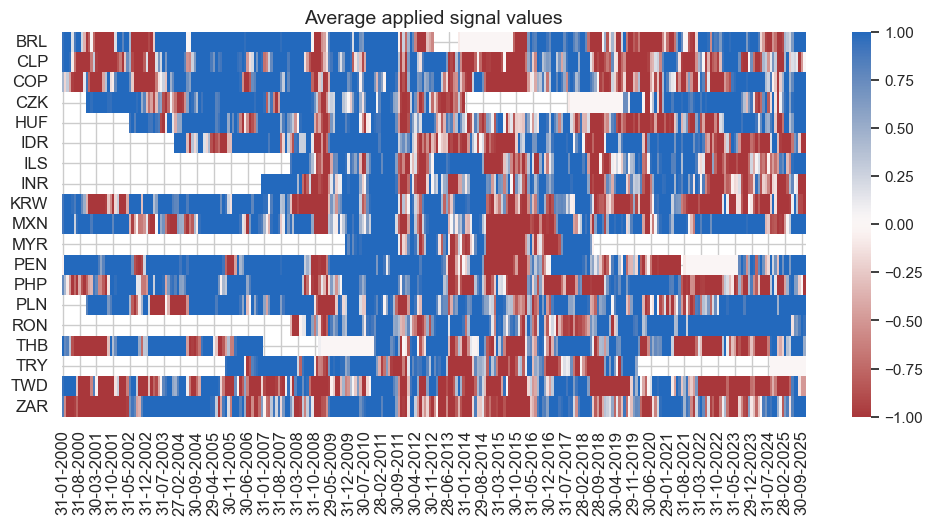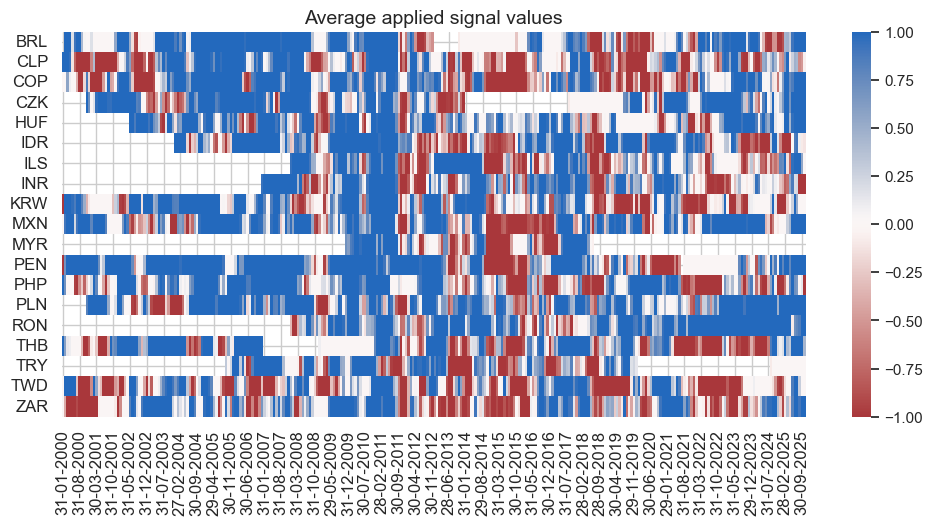Diversified trend following in emerging FX markets #
Get packages and JPMaQS data #
# Set up environment
import numpy as np
import pandas as pd
import matplotlib.pyplot as plt
import seaborn as sns
from scipy.stats import norm
import itertools
import macrosynergy.management as msm
import macrosynergy.panel as msp
import macrosynergy.signal as mss
import macrosynergy.pnl as msn
import macrosynergy.visuals as msv
from macrosynergy.download import JPMaQSDownload
from macrosynergy.management.utils import merge_categories
from datetime import timedelta, date, datetime
from itertools import combinations
import warnings
import os
warnings.simplefilter("ignore")
# Cross section lists
cids_g3 = ["EUR", "JPY", "USD"] # DM large currency areas
cids_dmsc = ["AUD", "CAD", "CHF", "GBP", "NOK", "NZD", "SEK"] # DM small currency areas
cids_latm = ["BRL", "COP", "CLP", "MXN", "PEN"] # Latam
cids_emea = ["CZK", "HUF", "ILS", "PLN", "RON", "RUB", "TRY", "ZAR"] # EMEA
cids_emas = ["IDR", "INR", "KRW", "MYR", "PHP", "THB", "TWD"] # EM Asia ex China
cids_dm = cids_g3 + cids_dmsc
cids_em = cids_latm + cids_emea + cids_emas
cids = cids_dm + cids_em
cids.sort()
# FX cross-section lists
cids_nofx = ["EUR", "USD", "RUB"] # not suitable for analysis
cids_fx = list(set(cids) - set(cids_nofx))
cids_fx.sort()
cids_dmfx = list(set(cids_dm).intersection(cids_fx))
cids_dmfx.sort()
cids_emfx = list(set(cids_em).intersection(cids_fx))
cids_emfx.sort()
cids_eur = ["CHF", "CZK", "HUF", "NOK", "PLN", "RON", "SEK"] # trading against EUR
cids_eud = ["GBP", "TRY"] # trading against EUR and USD
cids_usd = list(set(cids_fx) - set(cids_eur + cids_eud)) # trading against USD
# Category lists
xbts = [ # long-term trends
"MTBGDPRATIO_SA_3MMAv60MMA",
"CABGDPRATIO_SA_3MMAv60MMA",
"CABGDPRATIO_SA_1QMAv20QMA",
]
xbds = [ # shorter-term dynamcis
"MTBGDPRATIO_SA_3MMA_D1M1ML3",
"MTBGDPRATIO_SA_6MMA_D1M1ML6",
"CABGDPRATIO_SA_3MMA_D1M1ML3",
"CABGDPRATIO_SA_1QMA_D1Q1QL1"
]
xbs = xbts + xbds
niip = [ # NIIP
"NIIPGDP_NSA_D1M1ML12",
"NIIPGDP_NSA_D1Mv2YMA",
"NIIPGDP_NSA_D1Mv5YMA",
]
il = [ # International Liabilities
"IIPLIABGDP_NSA_D1M1ML12",
"IIPLIABGDP_NSA_D1Mv2YMA",
"IIPLIABGDP_NSA_D1Mv5YMA",
]
nils = niip + il
gdp = [
# Intutive growth estimates
"INTRGDP_NSA_P1M1ML12_3MMA",
"INTRGDPv5Y_NSA_P1M1ML12_3MMA",
"INTRGDP_NSA_P1M1ML12_D3M3ML3",
# Technical growth estimates
"RGDPTECH_SA_P1M1ML12_3MMA",
"RGDPTECHv5Y_SA_P1M1ML12_3MMA",
"RGDPTECH_SA_P1M1ML12_D3M3ML3",
]
# Excess inflation
cpi = [
"CPIH_SA_P1M1ML12",
"CPIH_SJA_P6M6ML6AR",
"CPIC_SA_P1M1ML12",
"CPIC_SJA_P6M6ML6AR",
]
cpi_aux = [
"INFTEFF_NSA",
"INFTARGET_NSA",
"INFE2Y_JA"
]
inf = cpi + cpi_aux
reer = [ # Real appreciation
"REER_NSA_P1M12ML1",
"REER_NSA_P1M60ML1"
]
pcr = [
"PCREDITBN_SJA_P1M1ML12",
"PCREDITGDP_SJA_D1M1ML12"
]
exp = [
"EXPORTS_SA_P1M1ML12_3MMA",
"EXPORTS_SA_P6M6ML6AR",
]
oth = reer + pcr + exp
main = xbs + nils + gdp + inf + oth
rets = [
"FXXR_NSA",
"FXXR_VT10",
"FXCRY_NSA",
"EQXR_NSA",
"FXTARGETED_NSA",
"FXUNTRADABLE_NSA",
]
xcats = main + rets
# Resultant tickers
tickers = [cid + "_" + xcat for cid in cids for xcat in xcats]
print(f"Maximum number of tickers is {len(tickers)}")
Maximum number of tickers is 1140
# Download series from J.P. Morgan DataQuery by tickers
start_date = "1998-01-01"
end_date = None
# Retrieve credentials
client_id: str = os.getenv("DQ_CLIENT_ID")
client_secret: str = os.getenv("DQ_CLIENT_SECRET")
with JPMaQSDownload(client_id=client_id, client_secret=client_secret) as dq:
df = dq.download(
tickers=tickers,
start_date=start_date,
end_date=end_date,
suppress_warning=True,
metrics=["value"],
report_time_taken=True,
show_progress=True,
)
Downloading data from JPMaQS.
Timestamp UTC: 2025-10-23 16:09:02
Connection successful!
Requesting data: 100%|██████████| 57/57 [00:11<00:00, 4.94it/s]
Downloading data: 100%|██████████| 57/57 [01:49<00:00, 1.93s/it]
Time taken to download data: 125.65 seconds.
Some expressions are missing from the downloaded data. Check logger output for complete list.
79 out of 1140 expressions are missing. To download the catalogue of all available expressions and filter the unavailable expressions, set `get_catalogue=True` in the call to `JPMaQSDownload.download()`.
dfx = df.copy()
dfx.info()
<class 'pandas.core.frame.DataFrame'>
RangeIndex: 7151073 entries, 0 to 7151072
Data columns (total 4 columns):
# Column Dtype
--- ------ -----
0 real_date datetime64[ns]
1 cid object
2 xcat object
3 value float64
dtypes: datetime64[ns](1), float64(1), object(2)
memory usage: 218.2+ MB
Blacklist, renamings, and availability check #
Blacklist dictionary #
dfb = df[df["xcat"].isin(["FXTARGETED_NSA", "FXUNTRADABLE_NSA"])].loc[
:, ["cid", "xcat", "real_date", "value"]
]
dfba = (
dfb.groupby(["cid", "real_date"])
.aggregate(value=pd.NamedAgg(column="value", aggfunc="max"))
.reset_index()
)
dfba["xcat"] = "FXBLACK"
fxblack = msp.make_blacklist(dfba, "FXBLACK")
fxblack
{'BRL': (Timestamp('2012-12-03 00:00:00'), Timestamp('2013-09-30 00:00:00')),
'CHF': (Timestamp('2011-10-03 00:00:00'), Timestamp('2015-01-30 00:00:00')),
'CZK': (Timestamp('2014-01-01 00:00:00'), Timestamp('2017-07-31 00:00:00')),
'ILS': (Timestamp('1999-01-01 00:00:00'), Timestamp('2005-12-30 00:00:00')),
'INR': (Timestamp('1999-01-01 00:00:00'), Timestamp('2004-12-31 00:00:00')),
'MYR_1': (Timestamp('1999-01-01 00:00:00'), Timestamp('2007-11-30 00:00:00')),
'MYR_2': (Timestamp('2018-07-02 00:00:00'), Timestamp('2025-10-22 00:00:00')),
'PEN': (Timestamp('2021-07-01 00:00:00'), Timestamp('2021-07-30 00:00:00')),
'RON': (Timestamp('1999-01-01 00:00:00'), Timestamp('2005-11-30 00:00:00')),
'RUB_1': (Timestamp('1999-01-01 00:00:00'), Timestamp('2005-11-30 00:00:00')),
'RUB_2': (Timestamp('2022-02-01 00:00:00'), Timestamp('2025-10-22 00:00:00')),
'THB': (Timestamp('2007-01-01 00:00:00'), Timestamp('2008-11-28 00:00:00')),
'TRY_1': (Timestamp('1999-01-01 00:00:00'), Timestamp('2003-09-30 00:00:00')),
'TRY_2': (Timestamp('2020-01-01 00:00:00'), Timestamp('2024-07-31 00:00:00'))}
Availability check #
# Replace quarterly tickers with approximately equivalent monthly tickers
dict_repl = {
"CABGDPRATIO_SA_1QMAv20QMA": "CABGDPRATIO_SA_3MMAv60MMA",
"CABGDPRATIO_SA_1QMA_D1Q1QL1": "CABGDPRATIO_SA_3MMA_D1M1ML3",
}
dfx["xcat"] = dfx["xcat"].replace(dict_repl, regex=False)
xcatx = [xb for xb in xbs if xb not in dict_repl.keys()]
cidx = cids
msm.check_availability(dfx, xcats=xcatx, cids=cidx, missing_recent=False)

xcatx = nils
cidx = cids
msm.check_availability(dfx, xcats=xcatx, cids=cidx, missing_recent=False)

xcatx = gdp
cidx = cids
msm.check_availability(dfx, xcats=xcatx, cids=cidx, missing_recent=False)

xcatx = inf
cidx = cids
msm.check_availability(dfx, xcats=xcatx, cids=cidx, missing_recent=False)

xcatx = oth
cidx = cids
msm.check_availability(dfx, xcats=xcatx, cids=cidx, missing_recent=False)

Feature engineering and checks #
External balance trends #
# Indicator list and visualization
xbx = [
"MTBGDPRATIO_SA_3MMAv60MMA",
"CABGDPRATIO_SA_3MMAv60MMA",
"MTBGDPRATIO_SA_3MMA_D1M1ML3",
"MTBGDPRATIO_SA_6MMA_D1M1ML6",
]
xcatx = xbx
cidx = cids_fx
msp.view_timelines(
dfx,
xcats=xcatx,
cids=cidx,
ncol=4,
start="2000-01-01",
same_y=False,
height=2.2,
size=(10, 10),
all_xticks=True,
)
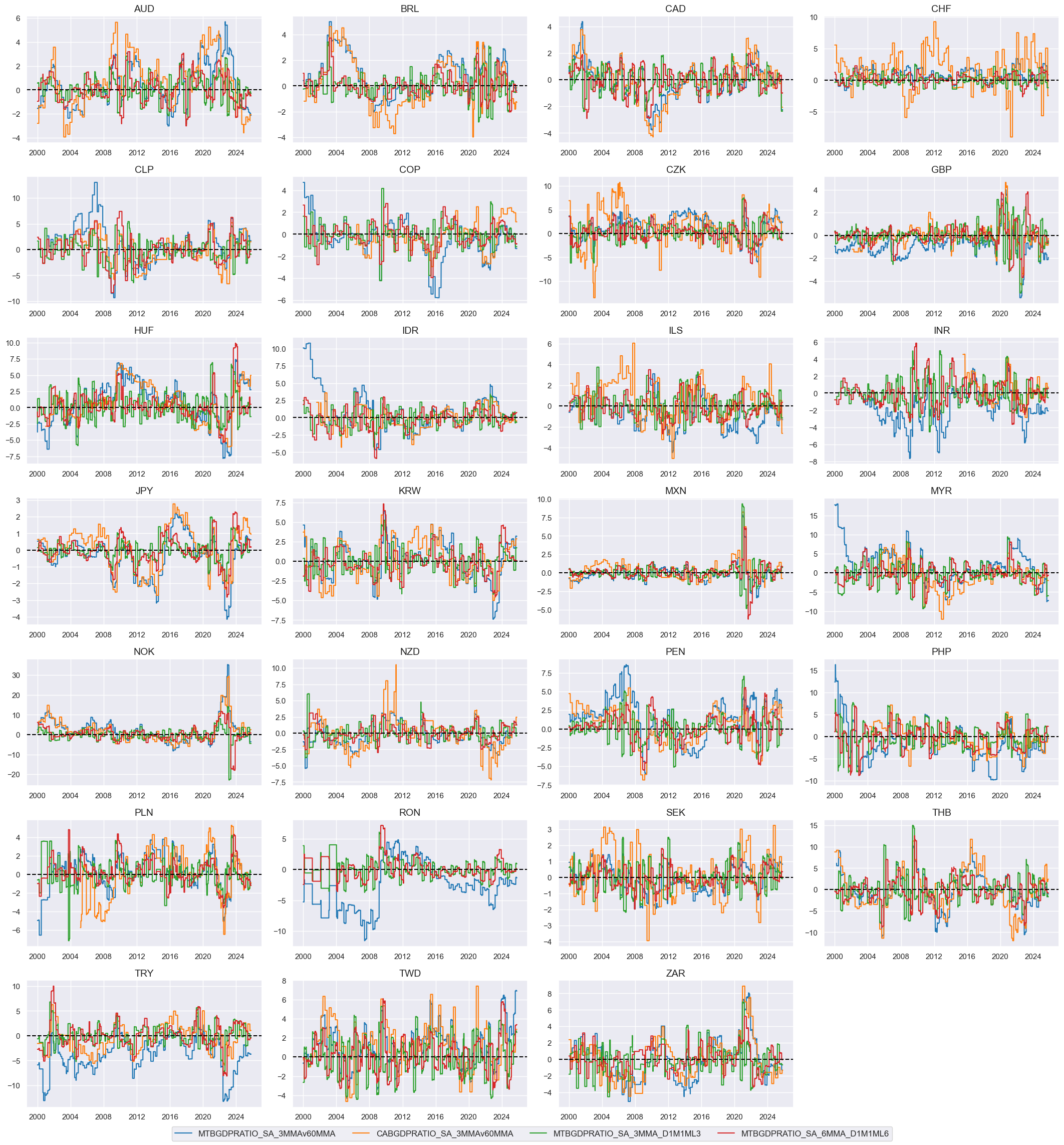
# Indicator scores
xcatx = xbx # shorter term dynamics
cidx = cids_fx
dfa = pd.DataFrame(columns=dfx.columns)
for xc in xcatx:
dfaa = msp.make_zn_scores(
dfx,
xcat=xc,
cids=cidx,
sequential=True,
min_obs=522, # oos scaling after 2 years of panel data
est_freq="m",
neutral="zero",
pan_weight=1,
thresh=3,
postfix="_ZN",
)
dfa = msm.update_df(dfa, dfaa)
dfx = msm.update_df(dfx, dfa)
# Weighted factor score
dict_indx = {
"MTBGDPRATIO_SA_3MMA_D1M1ML3_ZN": 1 / 4,
"MTBGDPRATIO_SA_6MMA_D1M1ML6_ZN": 1 / 4,
"MTBGDPRATIO_SA_3MMAv60MMA_ZN": 1 / 4,
"CABGDPRATIO_SA_3MMAv60MMA_ZN": 1 / 4,
}
fact = "XBTREND"
xcatx = list(dict_indx.keys())
weights = list(dict_indx.values())
cidx = cids_fx
# Create weighted composite
dfa = msp.linear_composite(
dfx,
xcats=xcatx,
weights=weights,
cids=cidx,
complete_xcats=False,
new_xcat=fact,
)
dfx = msm.update_df(dfx, dfa)
# Re-score the composite factor
dfa = msp.make_zn_scores(
dfx,
xcat=fact,
cids=cidx,
sequential=True,
min_obs=522, # oos scaling after 2 years of panel data
est_freq="m",
neutral="zero",
pan_weight=1,
thresh=3,
postfix="_ZN",
)
dfx = msm.update_df(dfx, dfa)
# Visualize factor score
msp.view_timelines(
dfx,
xcats=[fact + "_ZN"],
cids=cidx,
ncol=4,
start="2000-01-01",
same_y=True,
height=2.2,
size=(10, 10),
all_xticks=True,
)
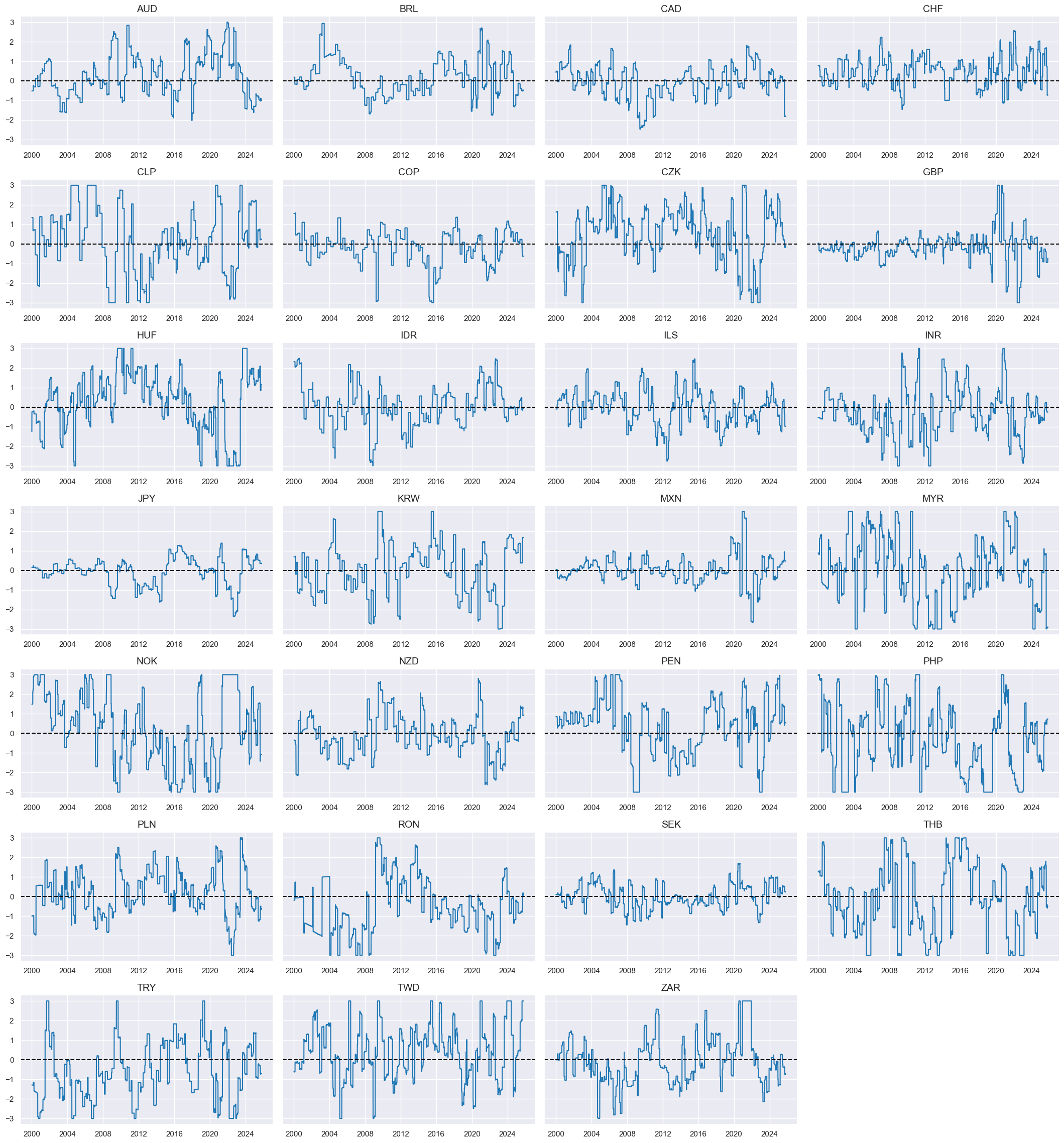
International investment trends #
# Change sign of liability growth
xcatx = nils
cidx = cids_fx
calcs = []
for xc in xcatx:
if "IIPLIABGDP" in xc:
calcs.append(f"{xc}_NEG = - {xc}")
dfa = msp.panel_calculator(dfx, calcs=calcs, cids=cidx)
dfx = msm.update_df(dfx, dfa)
# Indicator list and visualization
nilx = [
"NIIPGDP_NSA_D1M1ML12",
"NIIPGDP_NSA_D1Mv2YMA",
"NIIPGDP_NSA_D1Mv5YMA",
"IIPLIABGDP_NSA_D1M1ML12_NEG",
"IIPLIABGDP_NSA_D1Mv2YMA_NEG",
"IIPLIABGDP_NSA_D1Mv5YMA_NEG",
]
xcatx = nilx
cidx = cids_fx
msp.view_timelines(
dfx,
xcats=xcatx,
cids=cidx,
ncol=4,
start="2000-01-01",
same_y=False,
height=2.2,
size=(10, 10),
all_xticks=True,
)
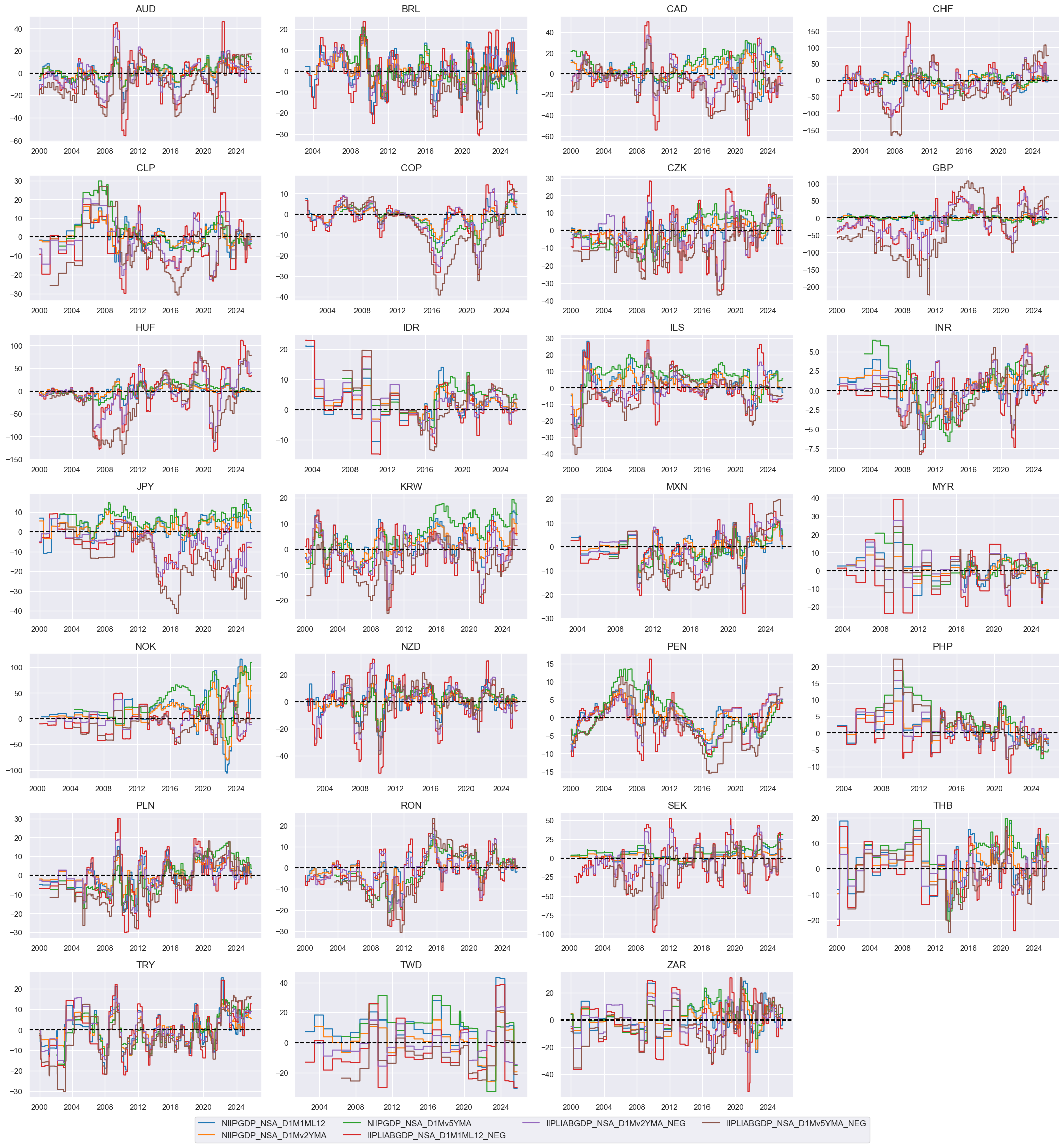
# Indicator scores
xcatx = nilx # shorter term dynamics
cidx = cids_fx
dfa = pd.DataFrame(columns=dfx.columns)
for xc in xcatx:
dfaa = msp.make_zn_scores(
dfx,
xcat=xc,
cids=cidx,
sequential=True,
min_obs=522, # oos scaling after 2 years of panel data
est_freq="m",
neutral="zero",
pan_weight=1,
thresh=3,
postfix="_ZN",
)
dfa = msm.update_df(dfa, dfaa)
dfx = msm.update_df(dfx, dfa)
# Weighted factor score
dict_indx = {
"NIIPGDP_NSA_D1M1ML12_ZN": 1 / 6,
"NIIPGDP_NSA_D1Mv2YMA_ZN": 1 / 6,
"NIIPGDP_NSA_D1Mv5YMA_ZN": 1 / 6,
"IIPLIABGDP_NSA_D1M1ML12_NEG_ZN": 1 / 6,
"IIPLIABGDP_NSA_D1Mv2YMA_NEG_ZN": 1 / 6,
"IIPLIABGDP_NSA_D1Mv5YMA_NEG_ZN": 1 / 6,
}
fact = "IITREND"
xcatx = list(dict_indx.keys())
weights = list(dict_indx.values())
cidx = cids_fx
# Create weighted composite
dfa = msp.linear_composite(
dfx,
xcats=xcatx,
weights=weights,
cids=cidx,
complete_xcats=False,
new_xcat=fact,
)
dfx = msm.update_df(dfx, dfa)
# Re-score the composite factor
dfa = msp.make_zn_scores(
dfx,
xcat=fact,
cids=cidx,
sequential=True,
min_obs=522, # oos scaling after 2 years of panel data
est_freq="m",
neutral="zero",
pan_weight=1,
thresh=3,
postfix="_ZN",
)
dfx = msm.update_df(dfx, dfa)
# Visualize factor score
msp.view_timelines(
dfx,
xcats=[fact + "_ZN"],
cids=cidx,
ncol=4,
start="2000-01-01",
same_y=True,
height=2.2,
size=(10, 10),
all_xticks=True,
)
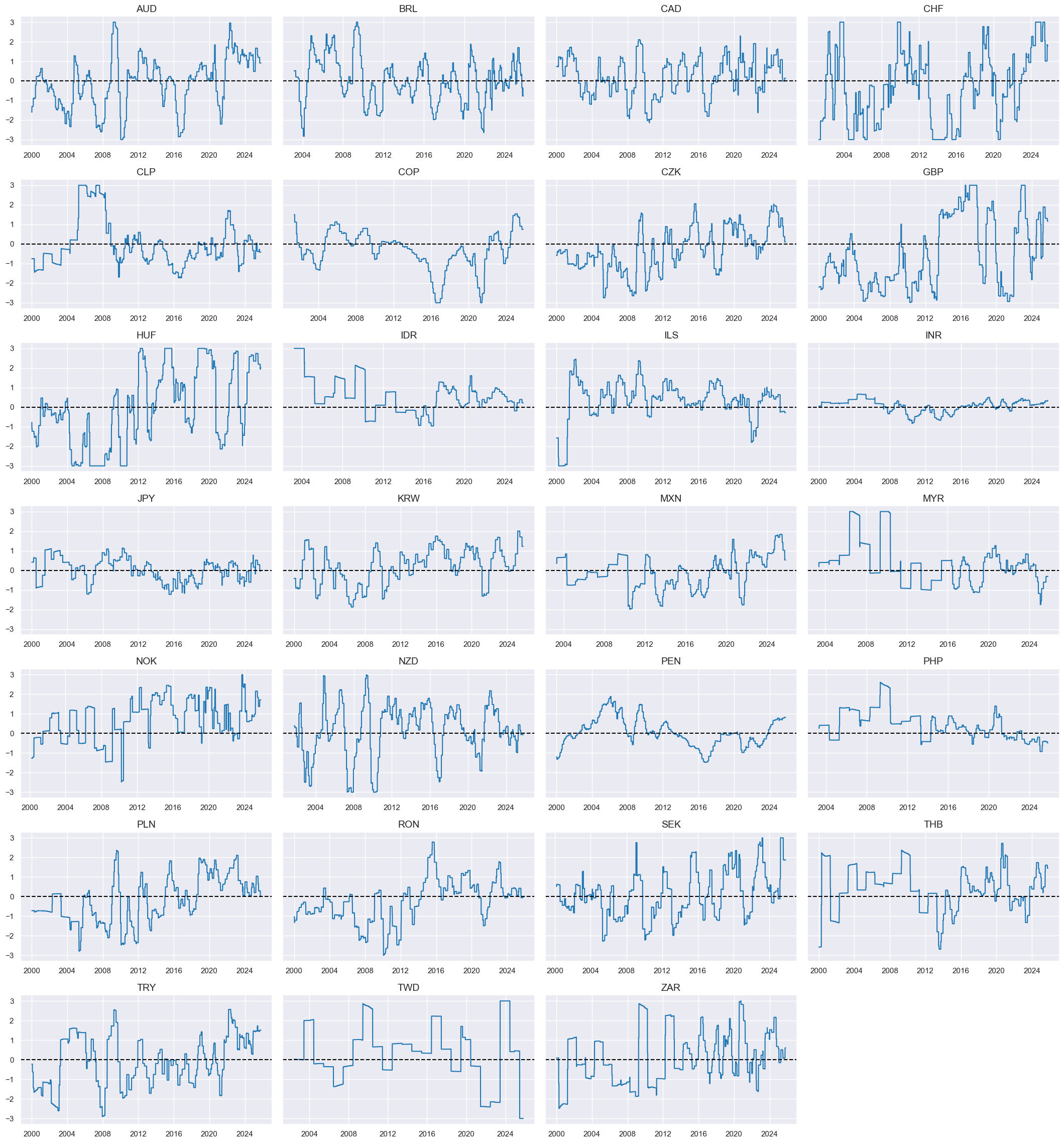
Relative excess inflation rates #
# Backward-extension of INFTARGET_NSA
# Duplicate targets
cidx = cids
calcs = [f"INFTARGET_BX = INFTARGET_NSA"]
dfa = msp.panel_calculator(dfx, calcs, cids=cidx)
# Add all dates back to 1990 to the frame, filling "value " with NaN
all_dates = np.sort(dfx['real_date'].unique())
all_combinations = pd.DataFrame(
list(itertools.product(dfa['cid'].unique(), dfa['xcat'].unique(), all_dates)),
columns=['cid', 'xcat', 'real_date']
)
dfax = pd.merge(all_combinations, dfa, on=['cid', 'xcat', 'real_date'], how='left')
# Backfill the values with first target value
dfax = dfax.sort_values(by=['cid', 'xcat', 'real_date'])
dfax['value'] = dfax.groupby(['cid', 'xcat'])['value'].bfill()
dfx = msm.update_df(dfx, dfax)
# Extended effective inflation target by hierarchical merging
hierarchy = ["INFTEFF_NSA", "INFTARGET_BX"]
dfa = merge_categories(dfx, xcats=hierarchy, new_xcat="INFTEFF_BX")
dfx = msm.update_df(dfx, dfa)
# Excess inflation rates relative to target inflation - minimum denominator of 2% to avoid extreme values
xcatx = cpi
calcs = [f"X{xc} = ( {xc} - INFTEFF_BX ) / np.clip( INFTEFF_BX , 2 , 9999 )" for xc in xcatx]
dfa = msp.panel_calculator(
dfx,
calcs=calcs,
cids=cids,
)
dfx = msm.update_df(dfx, dfa)
# Relative excess inflation rates
xcatx = cpi
dfa = pd.DataFrame(columns=list(dfx.columns))
for xc in xcatx:
calc_eur = [f"X{xc}vBM = X{xc} - iEUR_X{xc}"]
calc_usd = [f"X{xc}vBM = X{xc} - iUSD_X{xc}"]
calc_eud = [f"X{xc}vBM = X{xc} - 0.5 * ( iEUR_X{xc} + iUSD_X{xc} )"]
dfa_eur = msp.panel_calculator(dfx, calcs=calc_eur, cids=cids_eur)
dfa_usd = msp.panel_calculator(dfx, calcs=calc_usd, cids=cids_usd)
dfa_eud = msp.panel_calculator(dfx, calcs=calc_eud, cids=cids_eud)
dfa = msm.update_df(dfa, pd.concat([dfa_eur, dfa_usd, dfa_eud]))
dfx = msm.update_df(dfx, dfa)
# Indicator list and visualization
rxi = [
"XCPIH_SA_P1M1ML12vBM",
"XCPIH_SJA_P6M6ML6ARvBM",
"XCPIC_SA_P1M1ML12vBM",
"XCPIC_SJA_P6M6ML6ARvBM",
]
xcatx = rxi
cidx = cids_fx
msp.view_timelines(
dfx,
xcats=xcatx,
cids=cidx,
ncol=4,
start="2000-01-01",
same_y=False,
height=2.2,
size=(10, 10),
all_xticks=True,
)
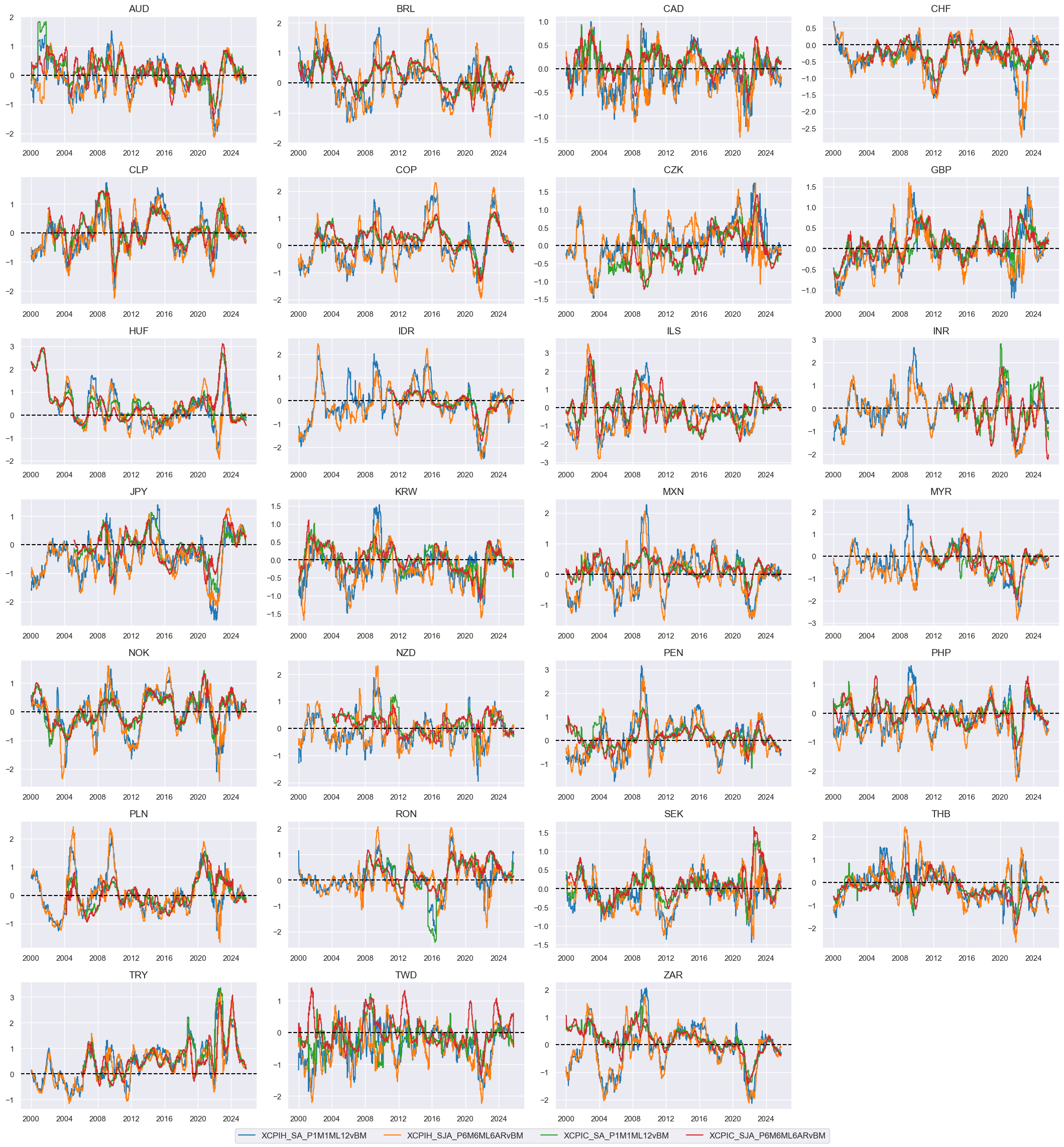
# Indicator scores
xcatx = rxi
cidx = cids_fx
dfa = pd.DataFrame(columns=dfx.columns)
for xc in xcatx:
dfaa = msp.make_zn_scores(
dfx,
xcat=xc,
cids=cidx,
sequential=True,
min_obs=522, # oos scaling after 2 years of panel data
est_freq="m",
neutral="zero",
pan_weight=1,
thresh=3,
postfix="_ZN",
)
dfa = msm.update_df(dfa, dfaa)
dfx = msm.update_df(dfx, dfa)
# Weighted factor score
dict_indx = {
"XCPIH_SA_P1M1ML12vBM_ZN": 1 / 4,
"XCPIH_SJA_P6M6ML6ARvBM_ZN": 1 / 4,
"XCPIC_SA_P1M1ML12vBM_ZN": 1 / 4,
"XCPIC_SJA_P6M6ML6ARvBM_ZN": 1 / 4,
}
fact = "RXINFTREND"
xcatx = list(dict_indx.keys())
weights = list(dict_indx.values())
cidx = cids_fx
# Create weighted composite
dfa = msp.linear_composite(
dfx,
xcats=xcatx,
weights=weights,
cids=cidx,
complete_xcats=False,
new_xcat=fact,
)
dfx = msm.update_df(dfx, dfa)
# Re-score the composite factor
dfa = msp.make_zn_scores(
dfx,
xcat=fact,
cids=cidx,
sequential=True,
min_obs=522, # oos scaling after 2 years of panel data
est_freq="m",
neutral="zero",
pan_weight=1,
thresh=3,
postfix="_ZN",
)
dfx = msm.update_df(dfx, dfa)
# Visualize factor score
msp.view_timelines(
dfx,
xcats=[fact + "_ZN"],
cids=cidx,
ncol=4,
start="2000-01-01",
same_y=True,
height=2.2,
size=(10, 10),
all_xticks=True,
)
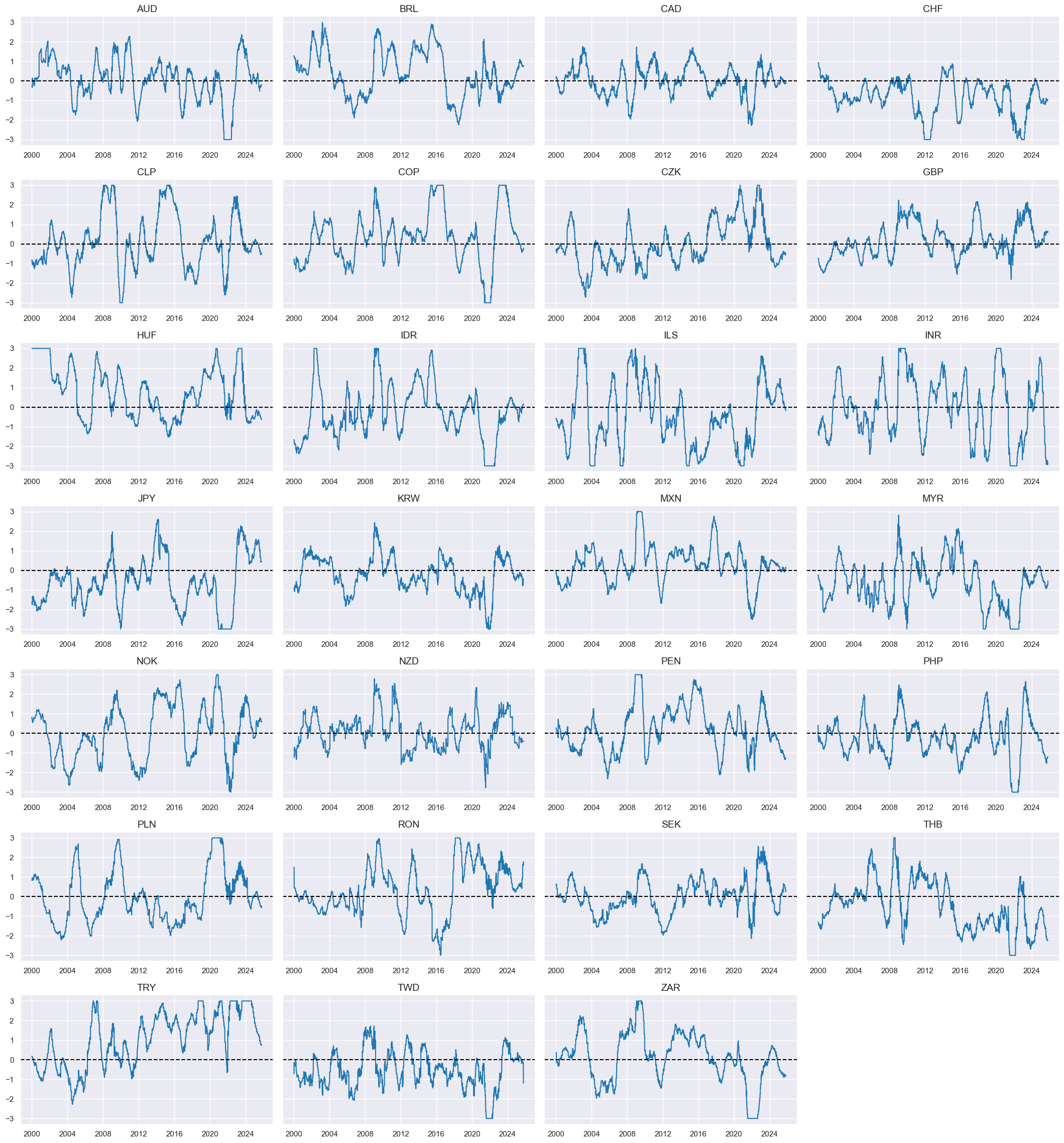
Relative growth trends #
# Relative growth rates
grow = [
"INTRGDP_NSA_P1M1ML12_3MMA",
"INTRGDPv5Y_NSA_P1M1ML12_3MMA",
"RGDPTECH_SA_P1M1ML12_3MMA",
"RGDPTECHv5Y_SA_P1M1ML12_3MMA",
]
xcatx = grow
dfa = pd.DataFrame(columns=list(dfx.columns))
for xc in xcatx:
calc_eur = [f"{xc}vBM = {xc} - iEUR_{xc}"]
calc_usd = [f"{xc}vBM = {xc} - iUSD_{xc}"]
calc_eud = [f"{xc}vBM = {xc} - 0.5 * ( iEUR_{xc} + iUSD_{xc} )"]
dfa_eur = msp.panel_calculator(dfx, calcs=calc_eur, cids=cids_eur)
dfa_usd = msp.panel_calculator(dfx, calcs=calc_usd, cids=cids_usd)
dfa_eud = msp.panel_calculator(dfx, calcs=calc_eud, cids=cids_eud)
dfa = msm.update_df(dfa, pd.concat([dfa_eur, dfa_usd, dfa_eud]))
dfx = msm.update_df(dfx, dfa)
# Indicator list and visualization
rgrow = [g + "vBM" for g in grow]
xcatx = rgrow
cidx = cids_fx
msp.view_timelines(
dfx,
xcats=xcatx,
cids=cidx,
ncol=4,
start="2000-01-01",
same_y=False,
height=2.2,
size=(10, 10),
all_xticks=True,
)
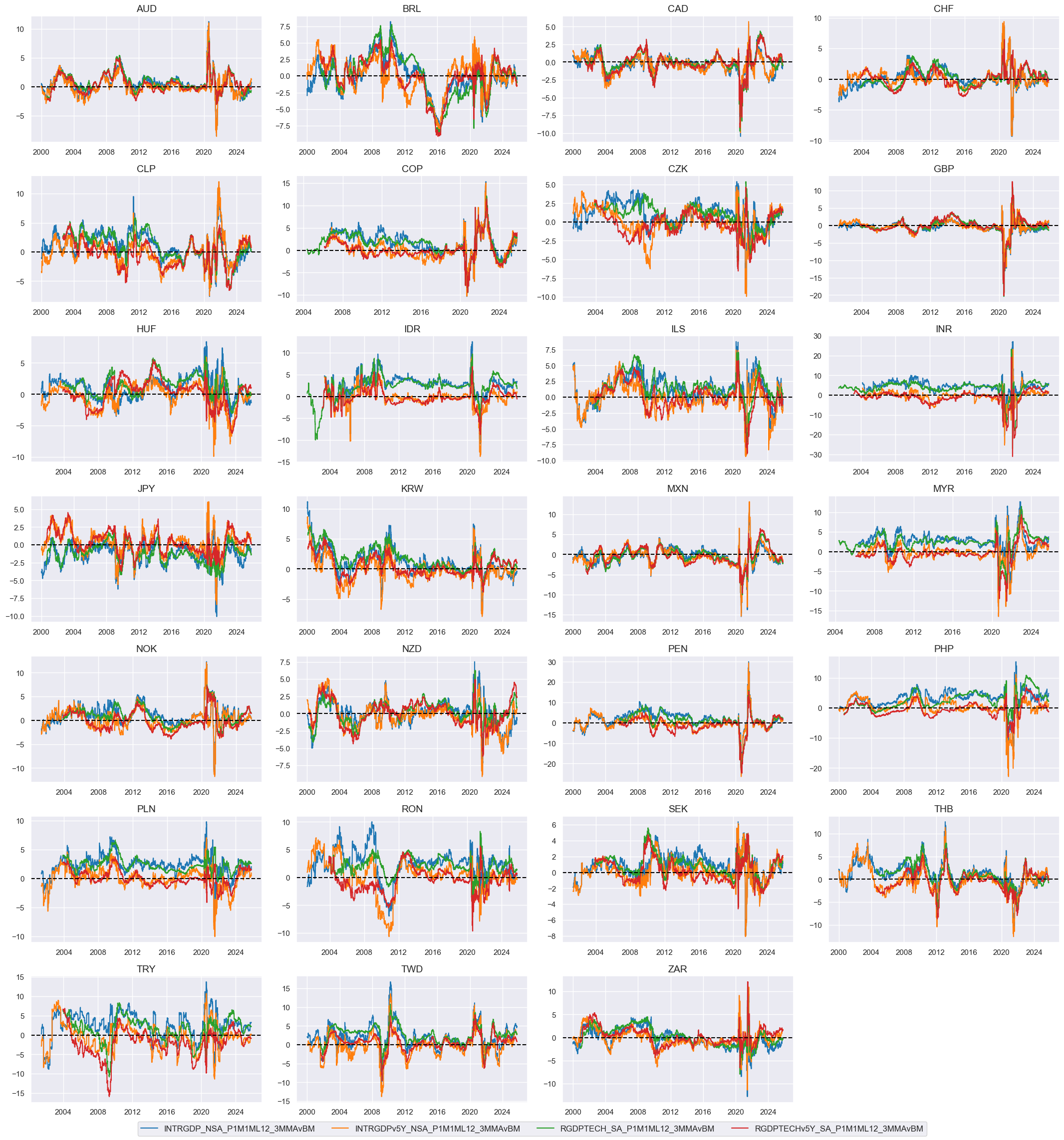
# Indicator scores
xcatx = rgrow
cidx = cids_fx
dfa = pd.DataFrame(columns=dfx.columns)
for xc in xcatx:
dfaa = msp.make_zn_scores(
dfx,
xcat=xc,
cids=cidx,
sequential=True,
min_obs=522, # oos scaling after 2 years of panel data
est_freq="m",
neutral="zero",
pan_weight=1,
thresh=3,
postfix="_ZN",
)
dfa = msm.update_df(dfa, dfaa)
dfx = msm.update_df(dfx, dfa)
# Weighted factor score
dict_indx = {
"INTRGDP_NSA_P1M1ML12_3MMAvBM_ZN": 1 / 4,
"INTRGDPv5Y_NSA_P1M1ML12_3MMAvBM_ZN": 1 / 4,
"RGDPTECH_SA_P1M1ML12_3MMAvBM_ZN": 1 / 4,
"RGDPTECHv5Y_SA_P1M1ML12_3MMAvBM_ZN": 1 / 4,
}
fact = "RGDPTREND"
xcatx = list(dict_indx.keys())
weights = list(dict_indx.values())
cidx = cids_fx
# Create weighted composite
dfa = msp.linear_composite(
dfx,
xcats=xcatx,
weights=weights,
cids=cidx,
complete_xcats=False,
new_xcat=fact,
)
dfx = msm.update_df(dfx, dfa)
# Re-score the composite factor
dfa = msp.make_zn_scores(
dfx,
xcat=fact,
cids=cidx,
sequential=True,
min_obs=522, # oos scaling after 2 years of panel data
est_freq="m",
neutral="zero",
pan_weight=1,
thresh=3,
postfix="_ZN",
)
dfx = msm.update_df(dfx, dfa)
# Visualize factor score
msp.view_timelines(
dfx,
xcats=[fact + "_ZN"],
cids=cidx,
ncol=4,
start="2000-01-01",
same_y=True,
height=2.2,
size=(10, 10),
all_xticks=True,
)
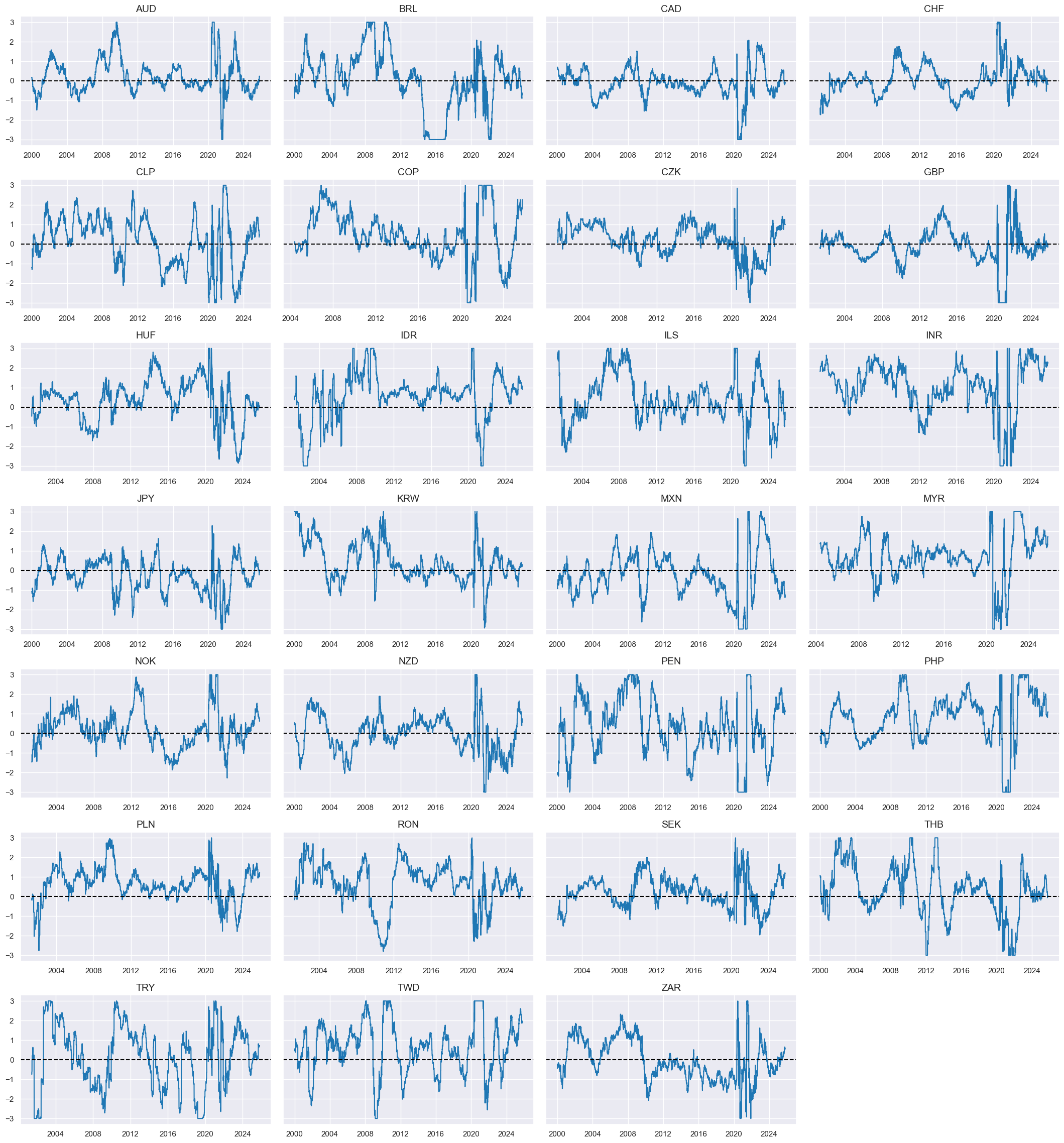
Local-currency currency export growth #
# Excess export growth rates (in excess of inflation target)
lcexp = [
"EXPORTS_SA_P1M1ML12_3MMA",
"EXPORTS_SA_P6M6ML6AR",
]
xcatx = lcexp
calcs = [f"X{xc} = {xc} - ( INFTEFF_BX )" for xc in xcatx]
dfa = msp.panel_calculator(
dfx,
calcs=calcs,
cids=cids,
)
dfx = msm.update_df(dfx, dfa)
xexp = ["X" + xc for xc in lcexp]
xcatx = xexp
cidx = cids_fx
msp.view_timelines(
dfx,
xcats=xcatx,
cids=cidx,
ncol=4,
start="2000-01-01",
same_y=False,
height=2.2,
size=(10, 10),
all_xticks=True,
)
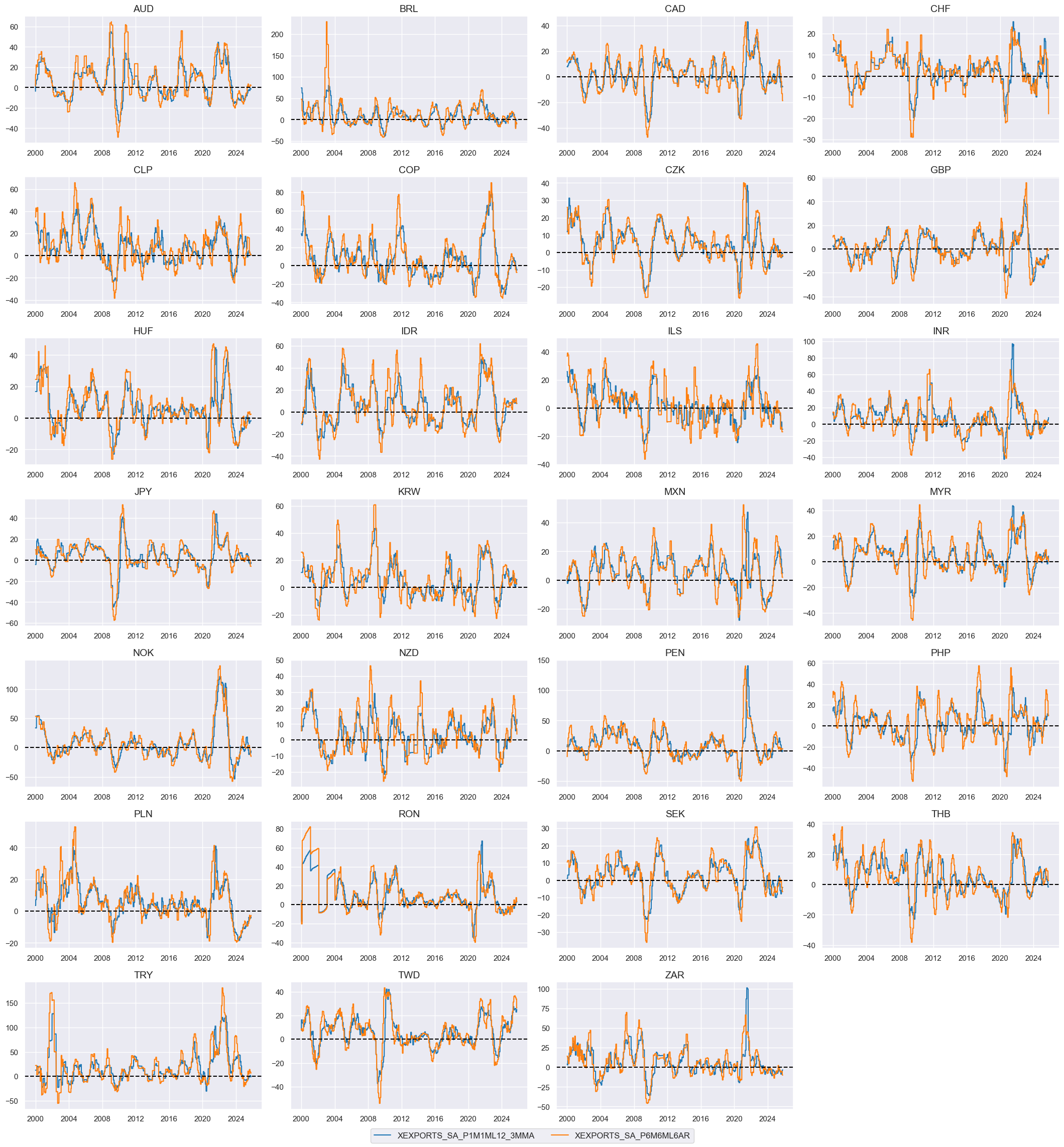
# Indicator scores
xcatx = xexp
cidx = cids_fx
dfa = pd.DataFrame(columns=dfx.columns)
for xc in xcatx:
dfaa = msp.make_zn_scores(
dfx,
xcat=xc,
cids=cidx,
sequential=True,
min_obs=522, # oos scaling after 2 years of panel data
est_freq="m",
neutral="zero",
pan_weight=1,
thresh=3,
postfix="_ZN",
)
dfa = msm.update_df(dfa, dfaa)
dfx = msm.update_df(dfx, dfa)
# Weighted factor score
dict_indx = {
"XEXPORTS_SA_P1M1ML12_3MMA_ZN": 1 / 2,
"XEXPORTS_SA_P6M6ML6AR_ZN": 1 / 2,
}
fact = "XEXPTREND"
xcatx = list(dict_indx.keys())
weights = list(dict_indx.values())
cidx = cids_fx
# Create weighted composite
dfa = msp.linear_composite(
dfx,
xcats=xcatx,
weights=weights,
cids=cidx,
complete_xcats=False,
new_xcat=fact,
)
dfx = msm.update_df(dfx, dfa)
# Re-score the composite factor
dfa = msp.make_zn_scores(
dfx,
xcat=fact,
cids=cidx,
sequential=True,
min_obs=522, # oos scaling after 2 years of panel data
est_freq="m",
neutral="zero",
pan_weight=1,
thresh=3,
postfix="_ZN",
)
dfx = msm.update_df(dfx, dfa)
# Visualize factor score
msp.view_timelines(
dfx,
xcats=[fact + "_ZN"],
cids=cidx,
ncol=4,
start="2000-01-01",
same_y=True,
height=2.2,
size=(10, 10),
all_xticks=True,
)
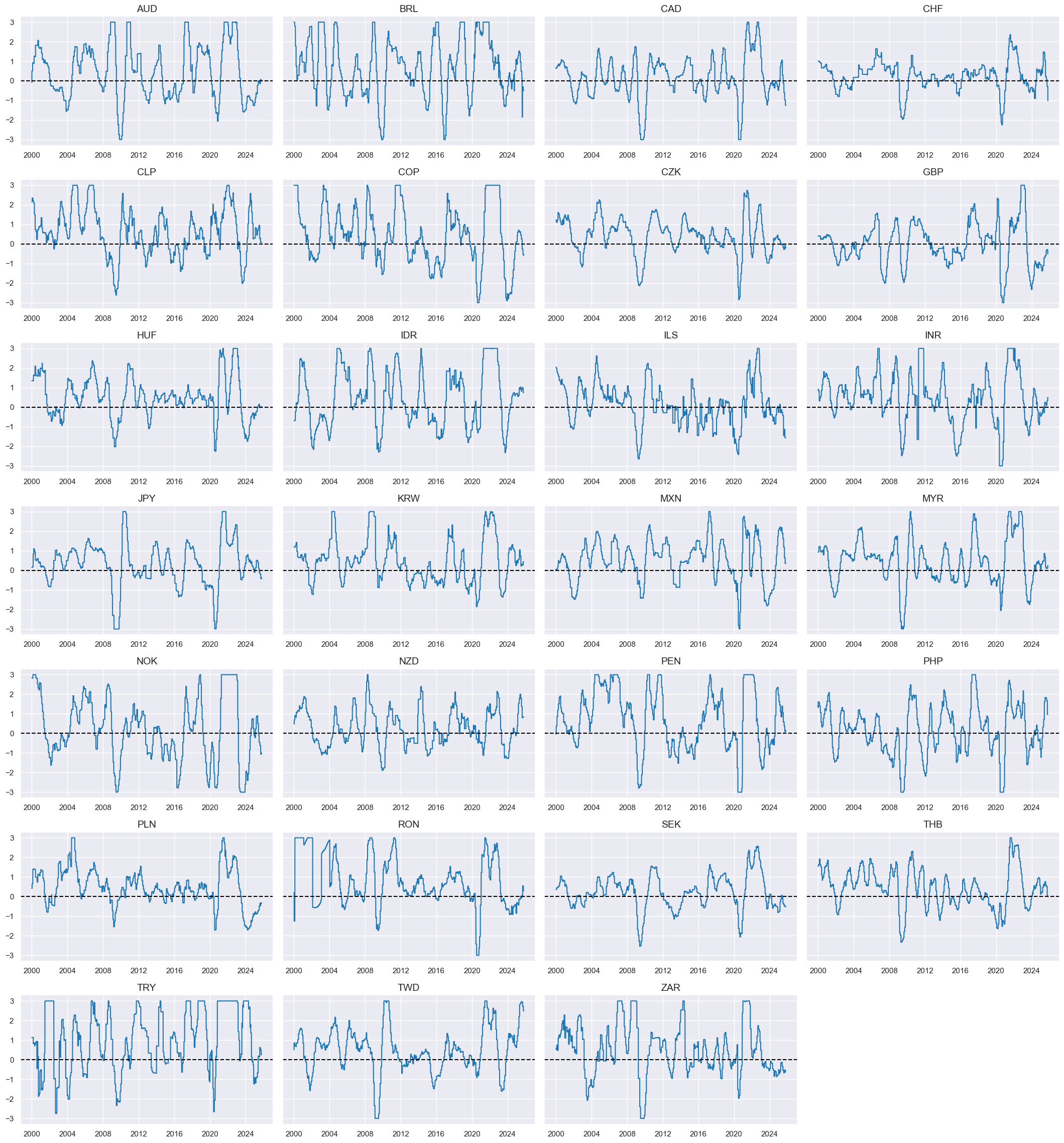
Composite macro support scores #
# Weighted linear combinations
factz = [
"XBTREND_ZN",
"IITREND_ZN",
"RGDPTREND_ZN",
"RXINFTREND_ZN",
"XEXPTREND_ZN",
]
xcatx = factz
sdate = "2000-01-01"
new_cat = "MACRO"
cidx = cids_fx
dfa = msp.linear_composite(
dfx,
xcats=xcatx,
cids=cidx,
complete_xcats=False,
start=sdate,
new_xcat=new_cat,
)
dfx = msm.update_df(dfx, dfa)
dfa = msp.make_zn_scores(
dfx,
xcat=new_cat,
cids=cidx,
sequential=True,
min_obs=261 * 5,
neutral="zero",
pan_weight=1,
thresh=3,
postfix="_ZC",
est_freq="m",
)
dfx = msm.update_df(dfx, dfa)
xcatx = ["MACRO_ZC"]
cidx = cids_emfx
msp.view_timelines(
dfx,
xcats=xcatx,
cids=cidx,
ncol=4,
start="2000-01-01",
same_y=False,
title="Composite macro support scores for FX forward positions in liquid emerging market currencies",
title_fontsize=26,
height=2,
size=(10, 10),
all_xticks=True,
)
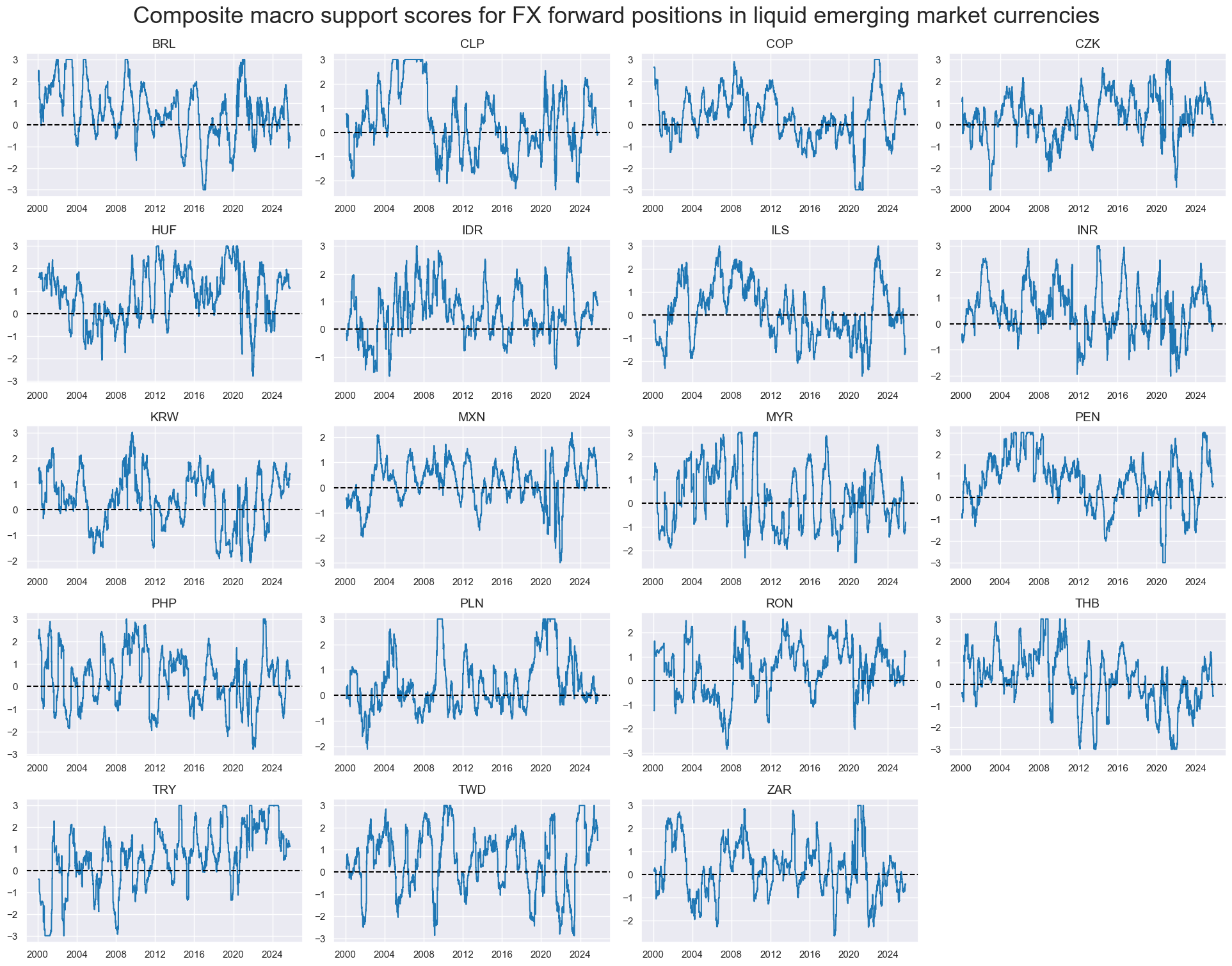
xcatx = factz
factz_labels = {
"XBTREND_ZN": "External balances",
"IITREND_ZN": "Investment positions",
"RGDPTREND_ZN": "Relative economic growth",
"RXINFTREND_ZN": "Relative excess inflation",
"XEXPTREND_ZN": "Excess export growth",
}
msp.correl_matrix(
dfx,
xcats=xcatx,
cids=cidx,
freq="M",
title="Cross-correlation of macro support factors, monthly frequency, 19 EM currency areas since 2000",
title_fontsize=20,
size=(13, 9),
max_color=0.6,
xcat_labels=factz_labels,
show=True,
annot=True
)
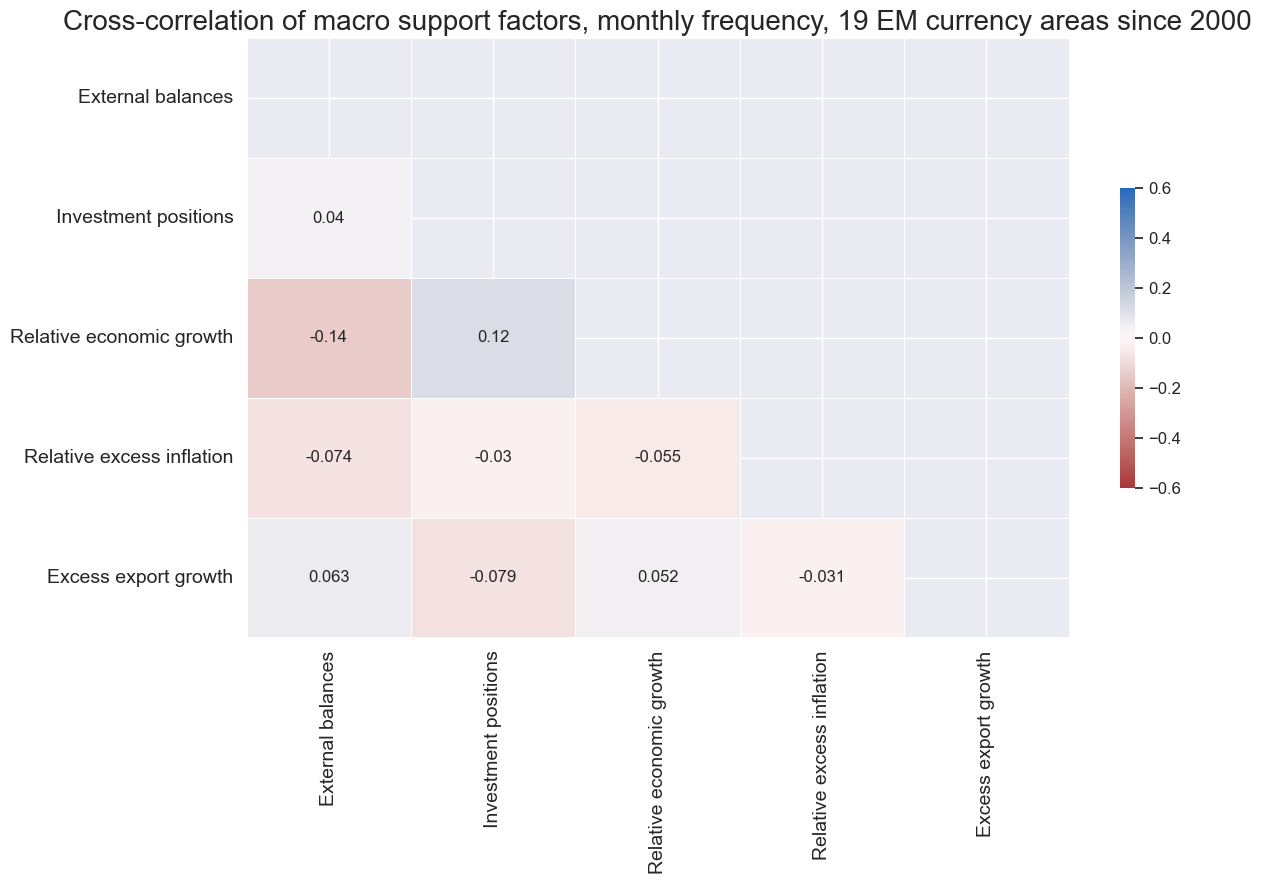
Trends #
Robust trends #
# Returns and adjustment scores
fxrs = ["FXXR_NSA"]
scoresz = [
"XBTREND_ZN",
"IITREND_ZN",
"RGDPTREND_ZN",
"RXINFTREND_ZN",
"XEXPTREND_ZN",
"MACRO_ZC",
]
# Creating a function that returns the cdf as dataframe
def norm_cdf_df(df):
"""Apply scipy.stats.norm.cdf to a DataFrame and return a DataFrame."""
return pd.DataFrame(norm.cdf(df.values), index=df.index, columns=df.columns)
# T-stat trend following strategy (Tzotchev, D. (2018).
cidx = cids_fx
lookbacks = [32, 64, 126, 252, 504] # 1.5, 3, 6, 12, 24 months
calcs = []
for fxr in fxrs:
signals = []
for lb in lookbacks:
mean_calc = f"{fxr}_MEAN_{lb} = {fxr}.rolling( {lb} ).mean( )"
std_calc = f"{fxr}_STD_{lb} = {fxr}.rolling( {lb} ).std( ddof=1 )"
tstat_calc = (
f"{fxr}_TSTAT_{lb} = {fxr}_MEAN_{lb} / ( {fxr}_STD_{lb} / np.sqrt( {lb} ) )"
)
prob_calc = f"{fxr}_PROB_{lb} = norm_cdf_df( {fxr}_TSTAT_{lb} )"
signal_calc = f"{fxr}_SIGNAL_{lb} = 2 * {fxr}_PROB_{lb} - 1"
signals.append( f"{fxr}_SIGNAL_{lb}" )
calcs += [mean_calc, std_calc, tstat_calc, prob_calc, signal_calc]
composite_signal = f"{fxr}_RTS = ( {' + '.join(signals)} ) / {len(lookbacks)}"
calcs.append(composite_signal)
# Calculate the signals
dfa = msp.panel_calculator(dfx, calcs, cids=cidx, blacklist=fxblack, external_func={"norm_cdf_df": norm_cdf_df})
dfx = msm.update_df(dfx, dfa)
# Rename trends for simplicity
dict_rename = {
"FXXR_NSA_RTS": "ROBFXR_TREND",
"FXNA_NSA_RTS": "ROBFNA_TREND",
}
dfx["xcat"] = dfx["xcat"].replace(dict_rename, regex=True)
# Composite signals names:
robtrends = ["ROBFXR_TREND"]
# Normalize trend signals sequentially (for modification)
xcatx = robtrends
cidx = cids_fx
for xc in xcatx:
dfaa = msp.make_zn_scores(
dfx,
xcat=xc,
cids=cidx,
sequential=True,
min_obs=522, # oos scaling after 2 years of panel data
est_freq="m",
neutral="zero",
pan_weight=1,
thresh=3,
postfix="Z",
)
dfa = msm.update_df(dfa, dfaa)
dfx = msm.update_df(dfx, dfa)
robtrends = [tr + "Z" for tr in robtrends]
xcatx = robtrends
cidx = cids_emfx
msp.view_timelines(
dfx,
xcats=xcatx,
cids=cidx,
ncol=4,
start="2000-01-01",
same_y=False,
height=2.2,
size=(10, 10),
all_xticks=True,
)
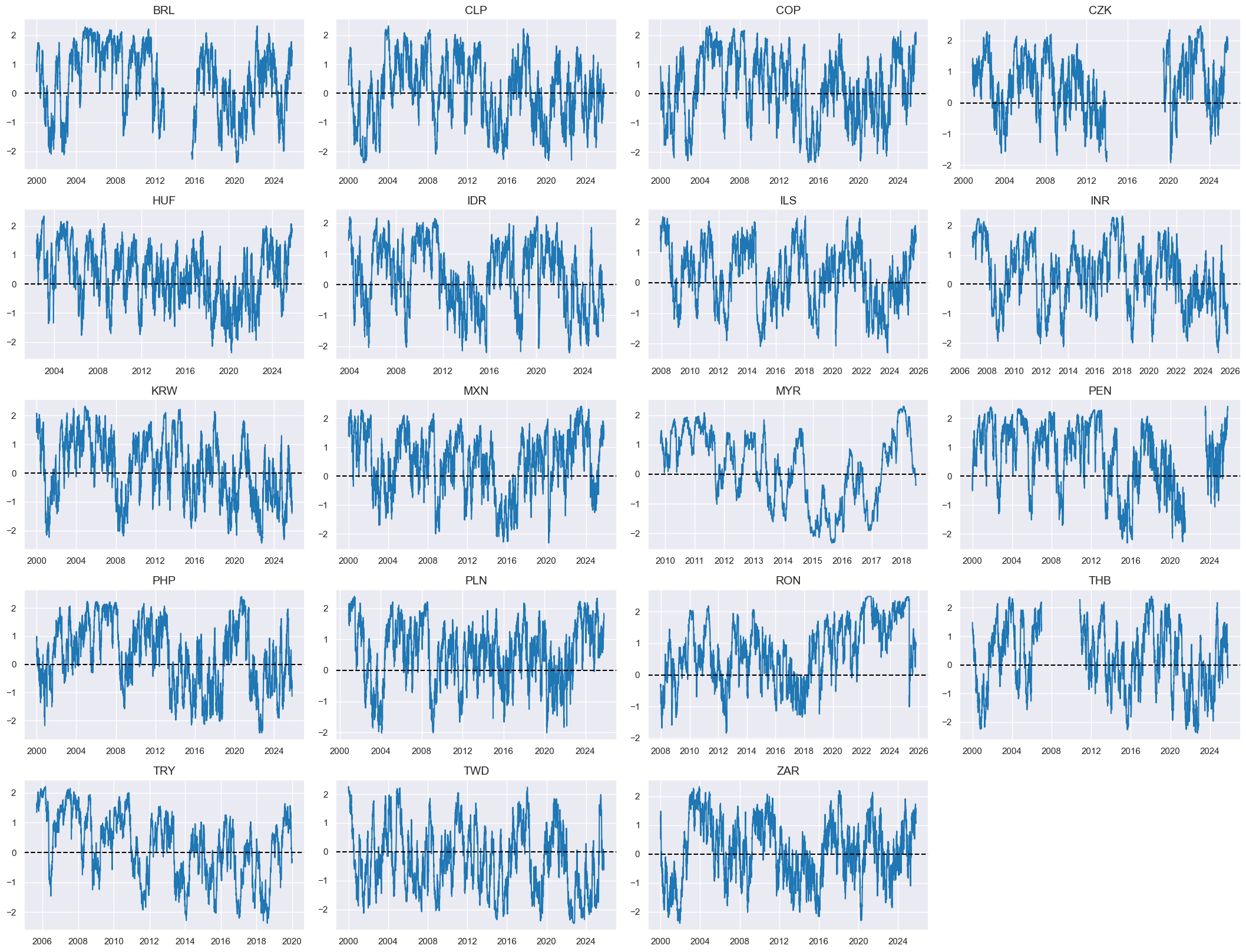
Modified robust trends #
# Illustrate sigmoid function
def sigmoid(x):
return 2 / (1 + np.exp(-2 * x))
ar = np.arange(-3, 3.2, 0.1)
plt.figure(figsize=(10, 5), dpi=80)
plt.plot(ar, sigmoid(ar))
plt.title(
"Sigmoid function that translates macro support scores into modification coefficients",
fontsize=15,
)
plt.show()
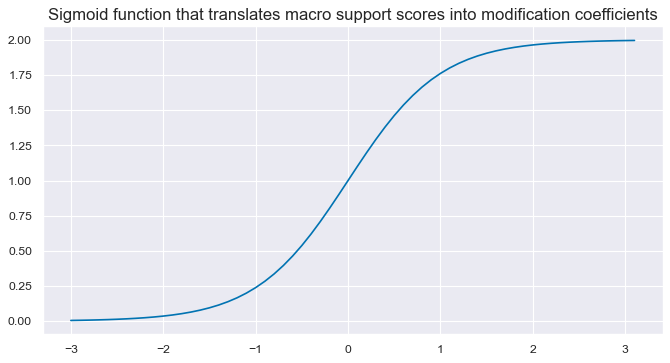
# Calculate general modification coefficients (independent of sign)
calcs = []
for zd in scoresz:
calcs += [f"{zd}_C = ( {zd} ).applymap( lambda x: 2 / (1 + np.exp( - 2 * x)) ) "]
dfa = msp.panel_calculator(dfx, calcs=calcs, cids=cidx)
dfx = msm.update_df(dfx, dfa)
# Visualize general modification coefficients
xcatx = ["MACRO_ZC", "MACRO_ZC_C"]
cidx = cids_emfx
msp.view_timelines(
dfx,
xcats=xcatx,
cids=cidx,
ncol=4,
start="2000-01-01",
same_y=False,
height=2.2,
size=(10, 10),
all_xticks=True,
)
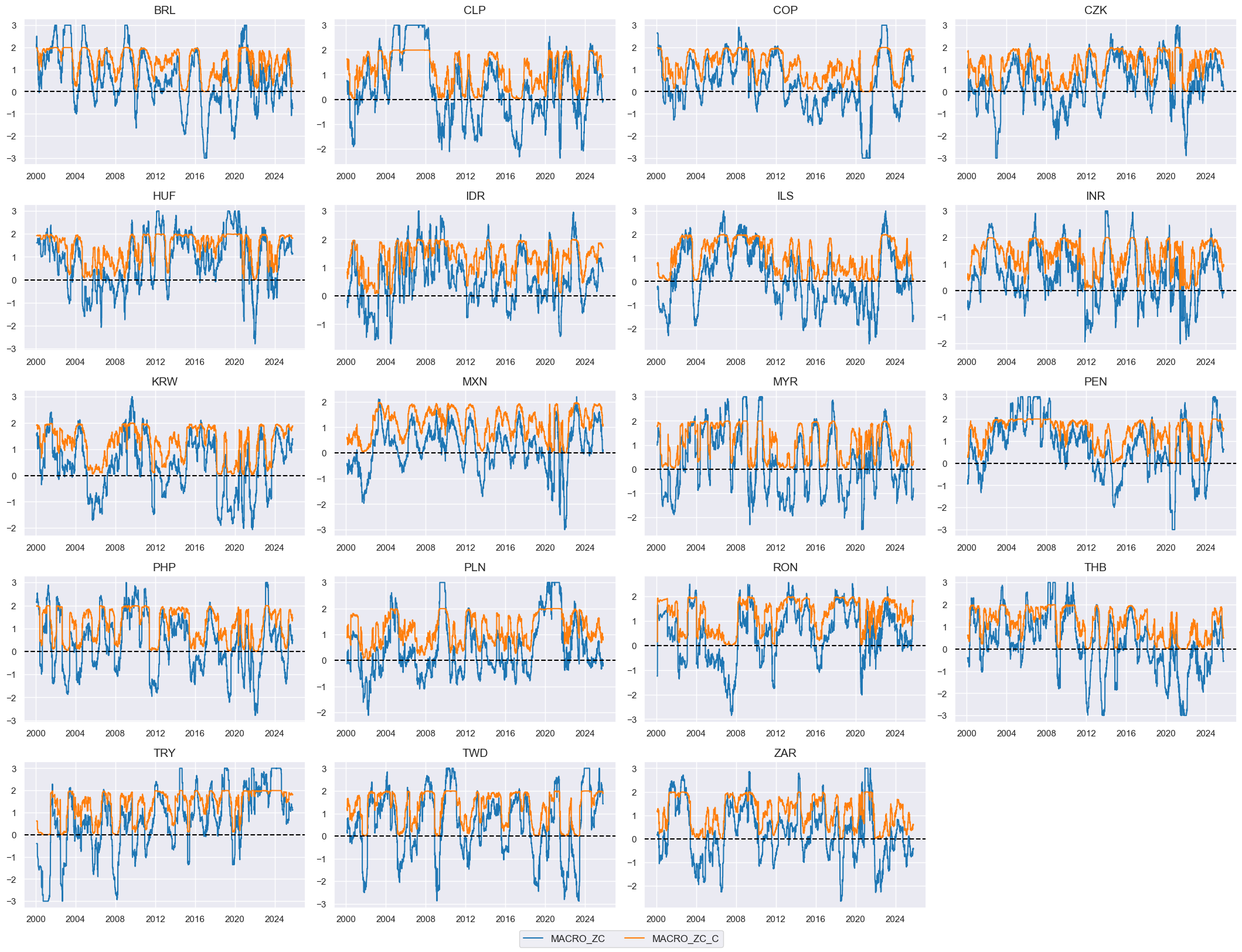
# Modified robust trends based on sign-dependent modification
calcs = []
for tr in robtrends:
for xs in scoresz:
trxs = tr + "m" + xs.split("_")[0]
calcs += [f"{trxs}_C = (1 - np.sign( {tr} )) + np.sign( {tr} ) * {xs}_C"]
calcs += [f"{trxs} = {trxs}_C * {tr}"]
dfa = msp.panel_calculator(dfx, calcs=calcs, cids=cids_fx, blacklist=fxblack)
dfx = msm.update_df(dfx, dfa)
rob_trends_mod = [xc for xc in dfa["xcat"].unique() if not xc.endswith("_C")]
xcatx = ["ROBFXR_TRENDZ", "ROBFXR_TRENDZmMACRO"]
cidx = cids_emfx
dict_labs = {
"ROBFXR_TRENDZ": "Market-based trend signal",
"ROBFXR_TRENDZmMACRO": "Modified trend signal",
}
msp.view_timelines(
dfx,
xcats=xcatx,
cids=cidx,
ncol=4,
start="2000-01-01",
same_y=False,
title="Market-based and modified trend signals for liquid EMFX forwards",
title_fontsize=26,
height=2,
size=(8, 8),
all_xticks=True,
xcat_labels=dict_labs,
legend_fontsize=16,
)
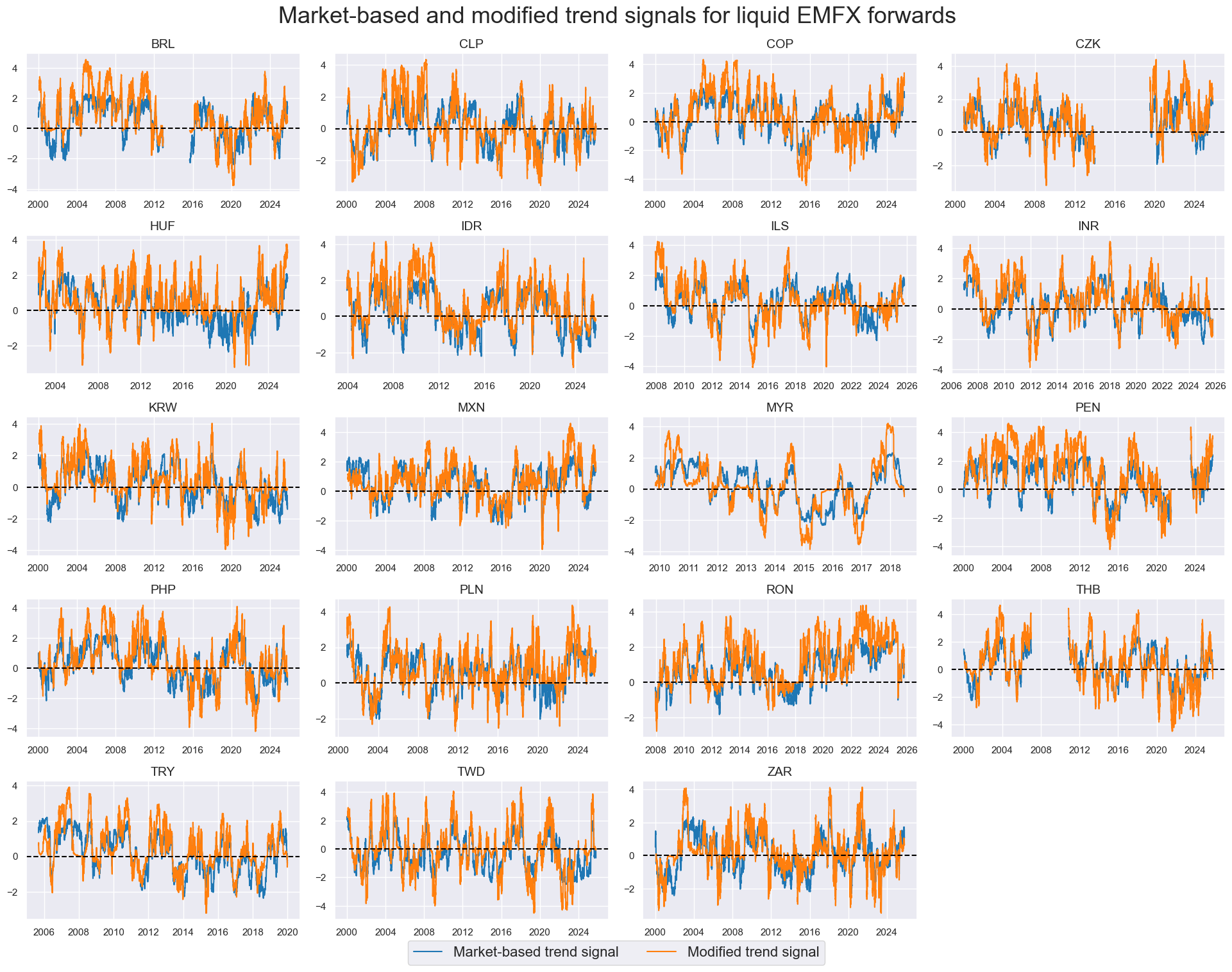
Balanced robust trends #
# Balanced robust trend calculation
calcs = []
for tr in robtrends:
for xs in scoresz:
trxs = tr + "b" + xs.split("_")[0]
calcs += [f"{trxs} = ( {tr} + ( {xs} ) ) / 2"]
dfa = msp.panel_calculator(dfx, calcs=calcs, cids=cids_fx, blacklist=fxblack)
dfx = msm.update_df(dfx, dfa)
rob_trends_bal = [xc for xc in dfa["xcat"].unique() if not xc.endswith("_C")]
xcatx = ["ROBFXR_TRENDZ", "ROBFXR_TRENDZbMACRO"]
cidx = cids_emfx
dict_labs = {
"ROBFXR_TRENDZ": "Market-based trend signal",
"ROBFXR_TRENDZbMACRO": "Balanced trend signal",
}
msp.view_timelines(
dfx,
xcats=xcatx,
cids=cidx,
ncol=4,
start="2000-01-01",
same_y=False,
title="Market-based and balanced trend signals for liquid EMFX forwards",
title_fontsize=26,
height=2,
size=(8, 8),
all_xticks=True,
xcat_labels=dict_labs,
legend_fontsize=16,
)
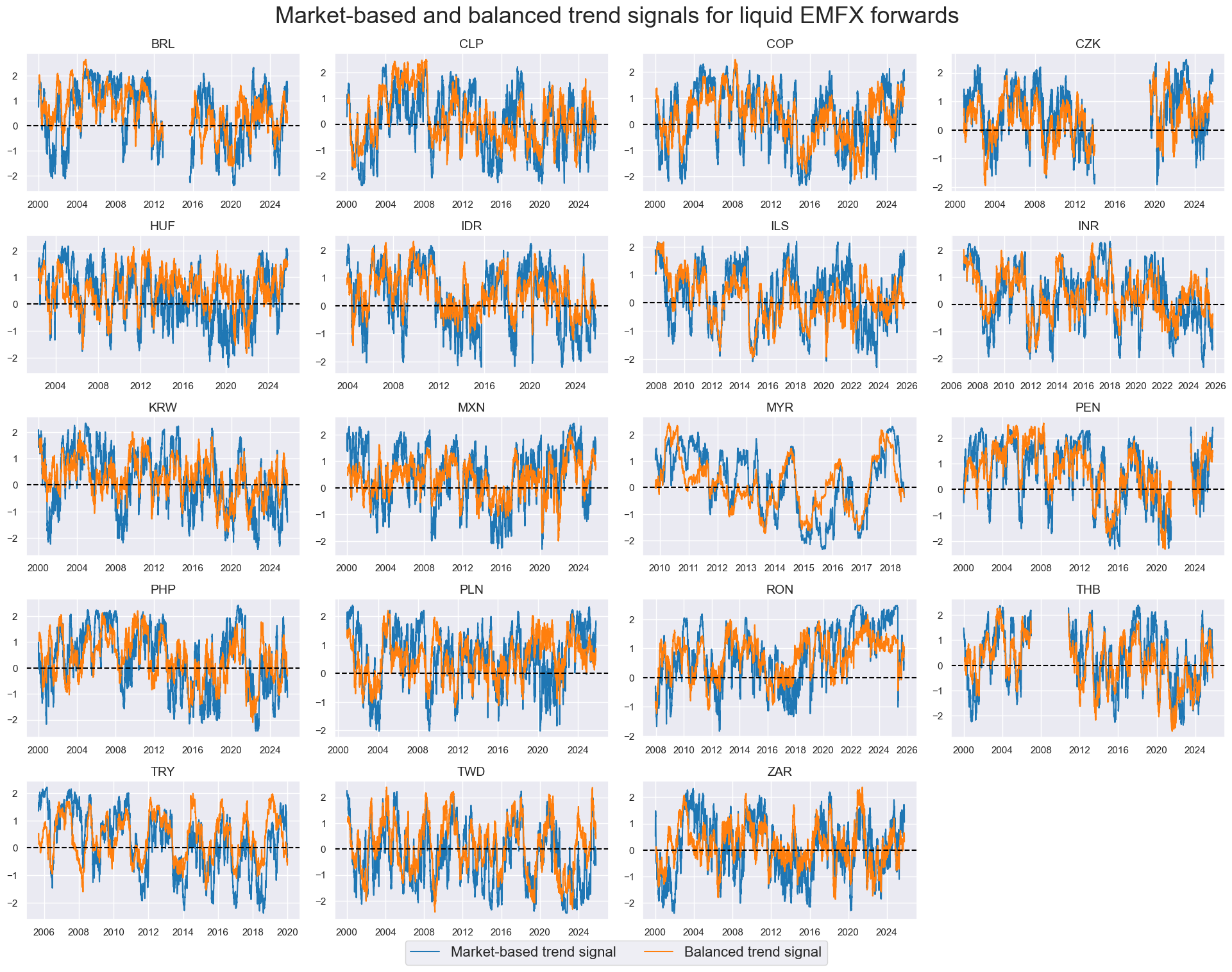
Targets #
Directional vol-targeted returns #
xcatx = ["FXXR_VT10"]
cidx = cids_fx
msp.view_timelines(
dfx,
xcats=xcatx,
cids=cidx,
ncol=4,
cumsum=True,
start="2000-01-01",
same_y=False,
height=2.2,
size=(10, 10),
all_xticks=True,
blacklist=fxblack,
)
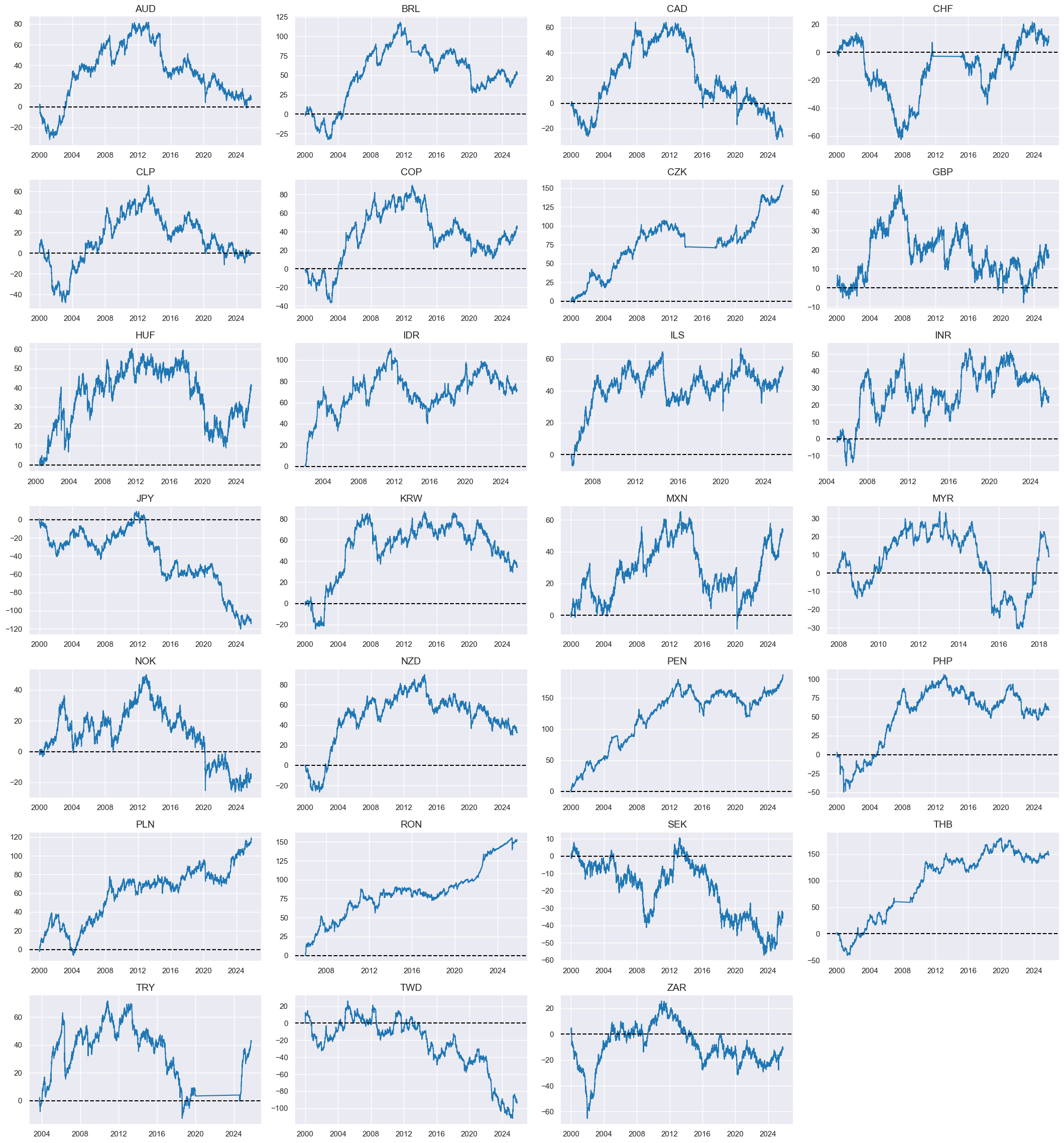
Value checks #
Specs and panel test #
sigs = [
"ROBFXR_TRENDZ",
"ROBFXR_TRENDZmMACRO",
"ROBFXR_TRENDZbMACRO",
]
targ = "FXXR_VT10"
cidx = cids_emfx
dict_rob = {
"sigs": sigs,
"targ": targ,
"cidx": cidx,
"black": fxblack,
"srr": None,
"pnls": None,
}
dix = dict_rob
sigs = dix["sigs"]
targ = dix["targ"]
cidx = dix["cidx"]
blax = dix["black"]
# Dictionary to store CategoryRelations objects
crx = []
# Create CategoryRelations objects for all signals
for sig in sigs:
crx.append(
msp.CategoryRelations(
dfx,
xcats=[sig, targ],
cids=cidx,
freq="M",
lag=1,
xcat_aggs=["last", "sum"],
start="2000-01-01",
blacklist=blax,
xcat_trims=[None, None],
)
)
# Display scatter plots for all signals
msv.multiple_reg_scatter(
cat_rels=crx,
coef_box="lower left",
ncol=3,
nrow=1,
separator=2013,
xlab="Trend signal at month-end",
ylab="FX forward return for 10% ar vol position, next month",
title="Various trend signals and subsequent vol-targeted 1-month FX forward returns, 19 EMs since 2000",
title_fontsize=20,
figsize=(16, 7),
prob_est="map",
subplot_titles=["Market trend signal", "Modified market trend signal", "Balanced market trend signal"],
share_axes=False,
)
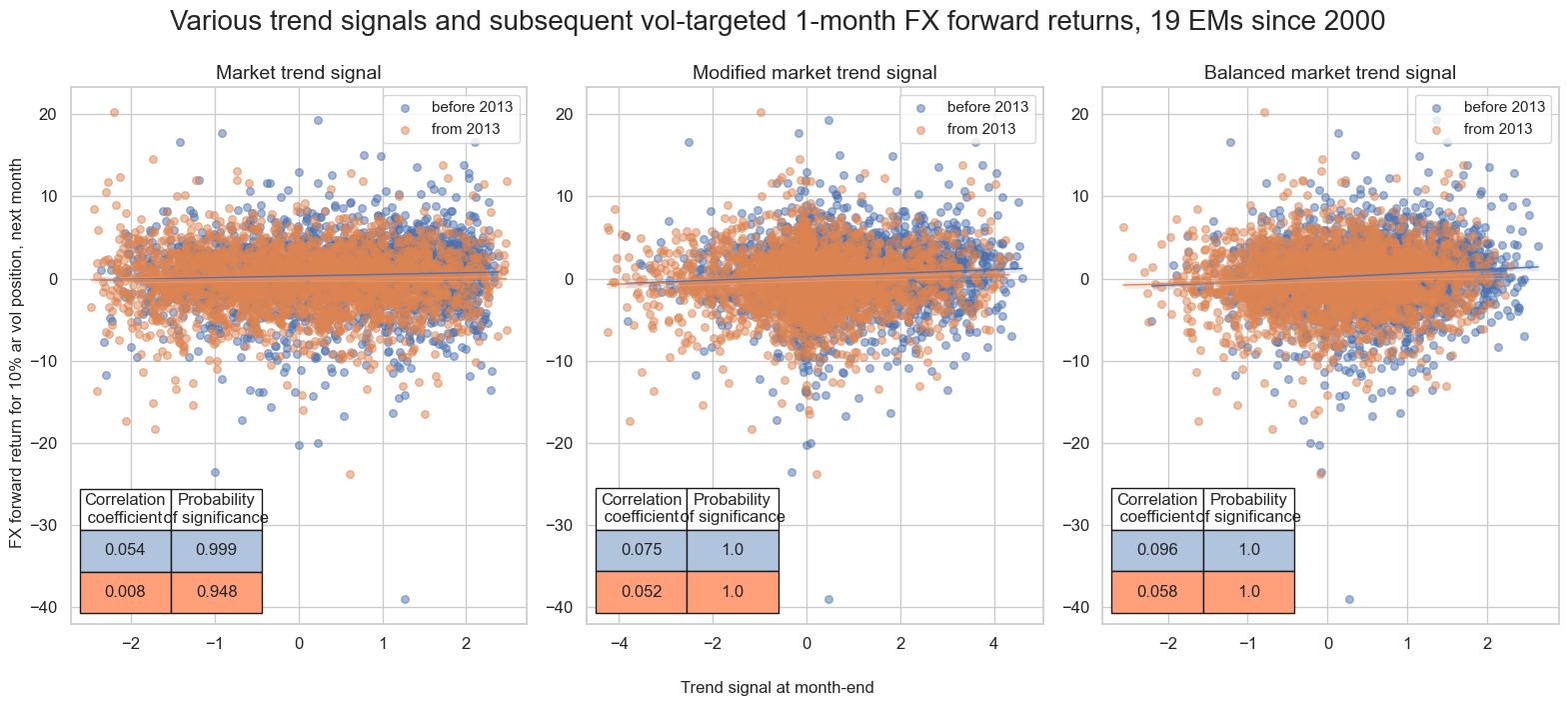
Accuracy and correlation check #
dix = dict_rob
sigs = dix["sigs"]
targ = dix["targ"]
cidx = dix["cidx"]
blax = dix["black"]
srr = mss.SignalReturnRelations(
dfx,
cids=cidx,
sigs=sigs,
rets=targ,
freqs="M",
start="2000-01-01",
blacklist=blax,
)
dix["srr"] = srr
dix = dict_rob
srrx = dix["srr"]
display(srrx.multiple_relations_table().round(3))
dict_labs = {
"ROBFXR_TRENDZ": "Market-based trend signal",
"ROBFXR_TRENDZmMACRO": "Modified trend signal",
"ROBFXR_TRENDZbMACRO": "Balanced trend signal",
}
srrx.accuracy_bars(type="signals",
title="Monthly accuracy metrics for various types of trend signals, 19 EMs since 2000",
freq="m",
size=(10, 4),
title_fontsize=15,
x_labels=dict_labs
)
| accuracy | bal_accuracy | pos_sigr | pos_retr | pos_prec | neg_prec | pearson | pearson_pval | kendall | kendall_pval | auc | ||||
|---|---|---|---|---|---|---|---|---|---|---|---|---|---|---|
| Return | Signal | Frequency | Aggregation | |||||||||||
| FXXR_VT10 | ROBFXR_TRENDZ | M | last | 0.536 | 0.527 | 0.607 | 0.547 | 0.568 | 0.485 | 0.043 | 0.002 | 0.035 | 0.0 | 0.526 |
| ROBFXR_TRENDZbMACRO | M | last | 0.551 | 0.540 | 0.667 | 0.547 | 0.574 | 0.506 | 0.089 | 0.000 | 0.060 | 0.0 | 0.536 | |
| ROBFXR_TRENDZmMACRO | M | last | 0.536 | 0.527 | 0.607 | 0.547 | 0.568 | 0.485 | 0.076 | 0.000 | 0.049 | 0.0 | 0.526 |
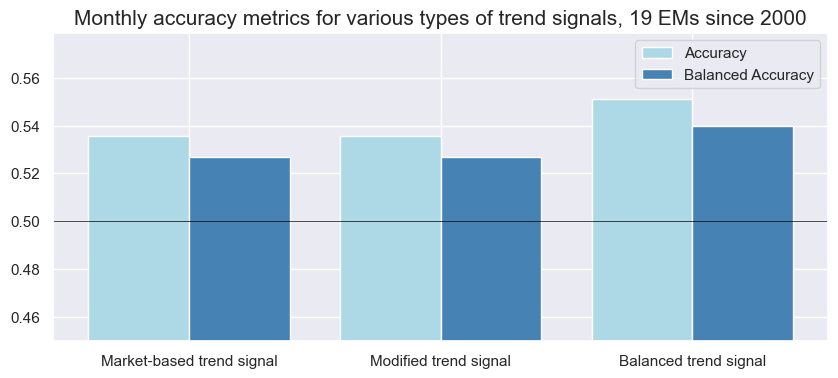
Naive PnL #
dix = dict_rob
sigx = dix["sigs"]
targ = dix["targ"]
cidx = dix["cidx"]
blax = dix["black"]
naive_pnl = msn.NaivePnL(
dfx,
ret=targ,
sigs=sigx,
cids=cidx,
start="2000-01-01",
blacklist=blax,
bms=["USD_EQXR_NSA"],
)
for sig in sigx:
naive_pnl.make_pnl(
sig,
sig_neg=False,
sig_op="raw",
thresh=5,
rebal_freq="daily",
vol_scale=10,
rebal_slip=1,
pnl_name=sig + "_PZN",
)
naive_pnl.make_long_pnl(vol_scale=10, label="Long only")
dix["pnls"] = naive_pnl
dix = dict_rob
sigx = dix["sigs"]
cidx = dix["cidx"]
naive_pnl = dix["pnls"]
pnls = [sig + "_PZN" for sig in sigx] + ["Long only"]
dict_labs = {
"ROBFXR_TRENDZ_PZN": "Market-based trend signal",
"ROBFXR_TRENDZmMACRO_PZN": "Modified trend signal",
"ROBFXR_TRENDZbMACRO_PZN": "Balanced trend signal",
"Long only": "Long-only risk parity",
}
naive_pnl.plot_pnls(
pnl_cats=pnls,
pnl_cids=["ALL"],
start="2000-01-01",
title="Naive PnLs for various trend signals and a long-only risk parity book in 19 EM FX forwards since 2000",
title_fontsize=16,
xcat_labels=dict_labs,
figsize=(12, 7),
)
df_eval = naive_pnl.evaluate_pnls(
pnl_cats=pnls,
pnl_cids=["ALL"],
start="2000-01-01",
)
display(df_eval.transpose().astype("float").round(2))
naive_pnl.signal_heatmap(
pnl_name='ROBFXR_TRENDZ_PZN',
pnl_cids=cidx,
freq="m",
start="2000-01-01",
figsize=(12, 6)
)
naive_pnl.signal_heatmap(
pnl_name='ROBFXR_TRENDZbMACRO_PZN',
pnl_cids=cidx,
freq="m",
start="2020-01-01",
figsize=(12, 6)
)
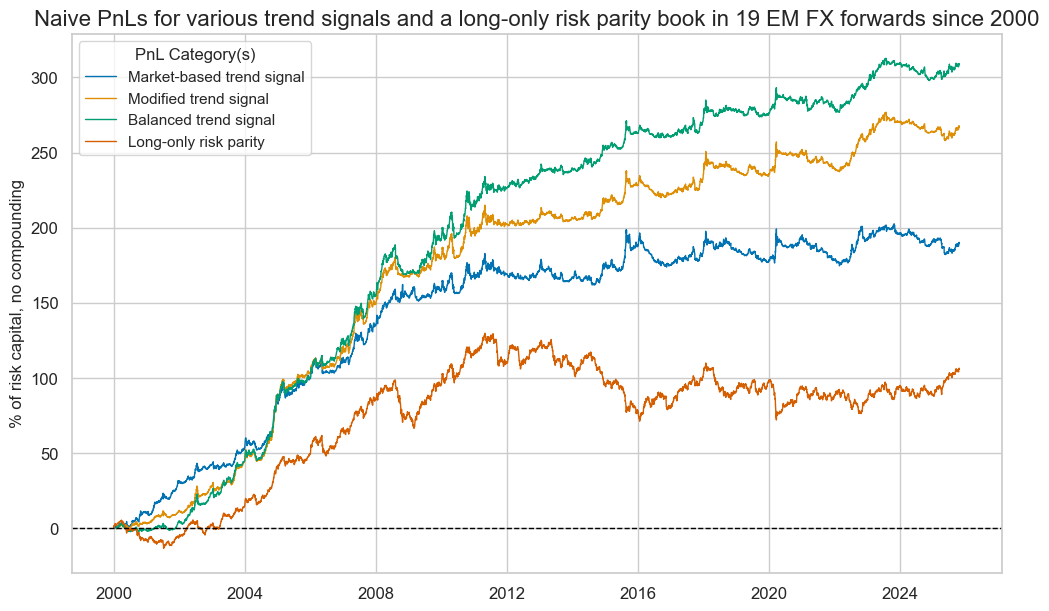
| Return % | St. Dev. % | Sharpe Ratio | Sortino Ratio | Max 21-Day Draw % | Max 6-Month Draw % | Peak to Trough Draw % | Top 5% Monthly PnL Share | USD_EQXR_NSA correl | Traded Months | |
|---|---|---|---|---|---|---|---|---|---|---|
| xcat | ||||||||||
| ROBFXR_TRENDZ_PZN | 7.35 | 10.0 | 0.73 | 1.04 | -12.73 | -18.51 | -24.88 | 0.76 | -0.03 | 310.0 |
| ROBFXR_TRENDZmMACRO_PZN | 10.38 | 10.0 | 1.04 | 1.49 | -16.03 | -12.57 | -19.85 | 0.61 | 0.04 | 310.0 |
| ROBFXR_TRENDZbMACRO_PZN | 11.99 | 10.0 | 1.20 | 1.73 | -17.40 | -17.71 | -19.91 | 0.51 | 0.08 | 310.0 |
| Long only | 4.10 | 10.0 | 0.41 | 0.56 | -21.26 | -26.00 | -58.50 | 1.08 | 0.32 | 310.0 |
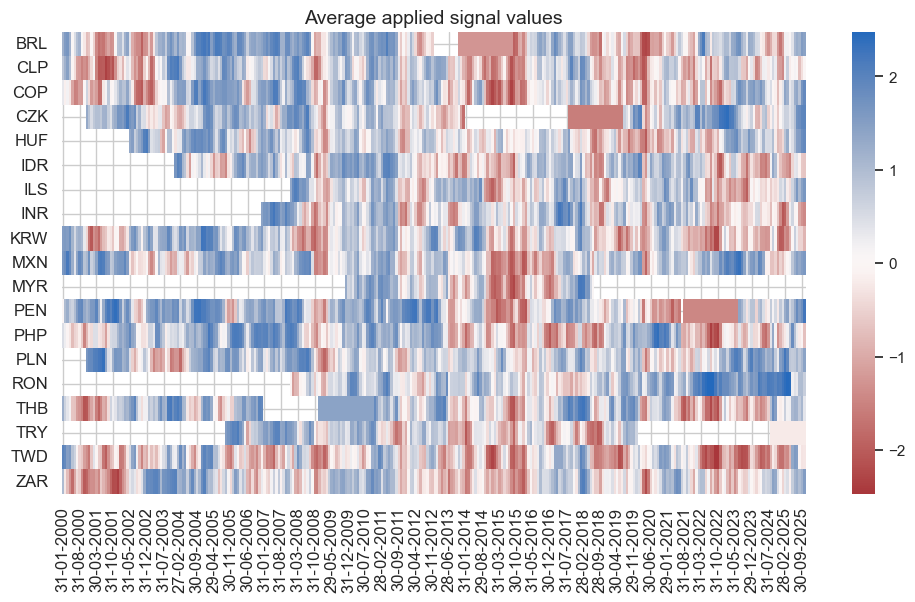
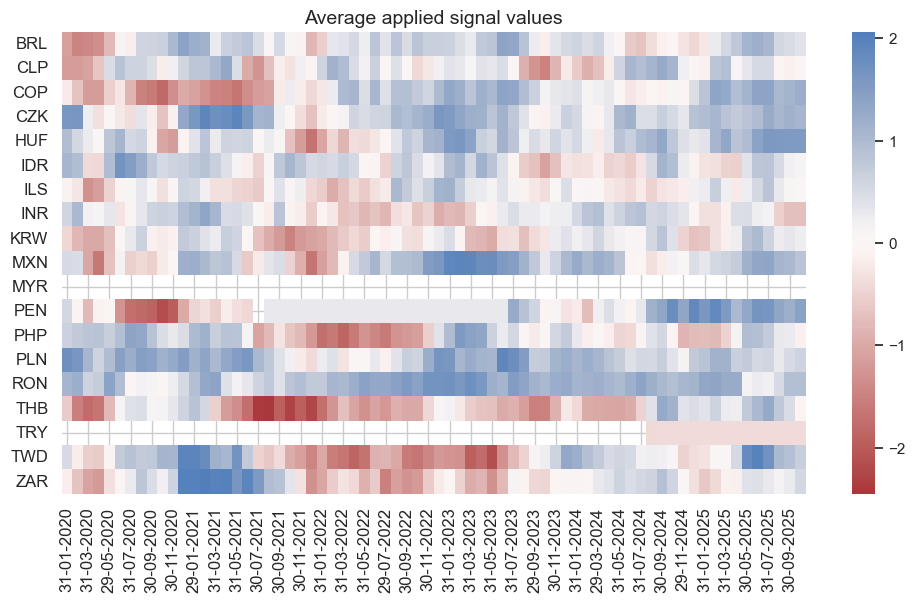
Naive PnL of binary strategy #
dix = dict_rob
sigx = dix["sigs"]
targ = dix["targ"]
cidx = dix["cidx"]
blax = dix["black"]
naive_pnl = msn.NaivePnL(
dfx,
ret=targ,
sigs=sigx,
cids=cidx,
start="2000-01-01",
blacklist=blax,
bms=["USD_EQXR_NSA"],
)
for sig in sigx:
naive_pnl.make_pnl(
sig,
sig_neg=False,
sig_op="binary",
entry_barrier=1.0,
exit_barrier=0.25,
rebal_freq="daily",
vol_scale=10,
rebal_slip=1,
pnl_name=sig + "_BIN",
)
naive_pnl.make_long_pnl(vol_scale=10, label="Long only")
dix["pnls2"] = naive_pnl
dix = dict_rob
sigx = dix["sigs"]
cidx = dix["cidx"]
naive_pnl = dix["pnls2"]
pnls = [sig + "_BIN" for sig in sigx] + ["Long only"]
dict_labs = {
"ROBFXR_TRENDZ_BIN": "Binary market trend signal",
"ROBFXR_TRENDZmMACRO_BIN": "Binary modified trend signal",
"ROBFXR_TRENDZbMACRO_BIN": "Binary balanced trend signal",
"Long only": "Long-only risk parity",
}
naive_pnl.plot_pnls(
pnl_cats=pnls,
pnl_cids=["ALL"],
start="2000-01-01",
title="Naive PnLs for binary trend signals and a long-only risk parity book in 19 EM FX forwards since 2000",
title_fontsize=16,
xcat_labels=dict_labs,
figsize=(12, 7),
)
df_eval = naive_pnl.evaluate_pnls(
pnl_cats=pnls,
pnl_cids=["ALL"],
start="2000-01-01",
)
display(df_eval.transpose().astype("float").round(2))
naive_pnl.signal_heatmap(
pnl_name='ROBFXR_TRENDZ_BIN',
pnl_cids=cidx,
freq="m",
start="2000-01-01",
figsize=(12, 5)
)
naive_pnl.signal_heatmap(
pnl_name='ROBFXR_TRENDZmMACRO_BIN',
pnl_cids=cidx,
freq="m",
start="2000-01-01",
figsize=(12, 5)
)
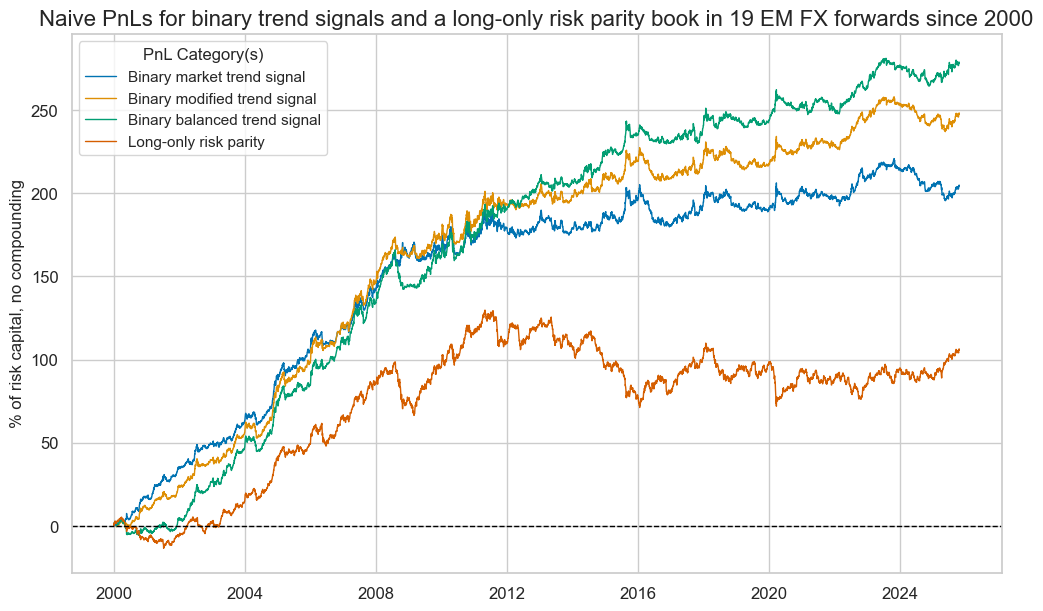
| Return % | St. Dev. % | Sharpe Ratio | Sortino Ratio | Max 21-Day Draw % | Max 6-Month Draw % | Peak to Trough Draw % | Top 5% Monthly PnL Share | USD_EQXR_NSA correl | Traded Months | |
|---|---|---|---|---|---|---|---|---|---|---|
| xcat | ||||||||||
| ROBFXR_TRENDZ_BIN | 7.93 | 10.0 | 0.79 | 1.13 | -14.70 | -21.23 | -25.36 | 0.62 | -0.01 | 310.0 |
| ROBFXR_TRENDZmMACRO_BIN | 9.63 | 10.0 | 0.96 | 1.38 | -16.82 | -17.74 | -20.91 | 0.54 | 0.03 | 310.0 |
| ROBFXR_TRENDZbMACRO_BIN | 10.81 | 10.0 | 1.08 | 1.56 | -16.73 | -21.16 | -23.73 | 0.49 | 0.08 | 310.0 |
| Long only | 4.10 | 10.0 | 0.41 | 0.56 | -21.26 | -26.00 | -58.50 | 1.08 | 0.32 | 310.0 |
